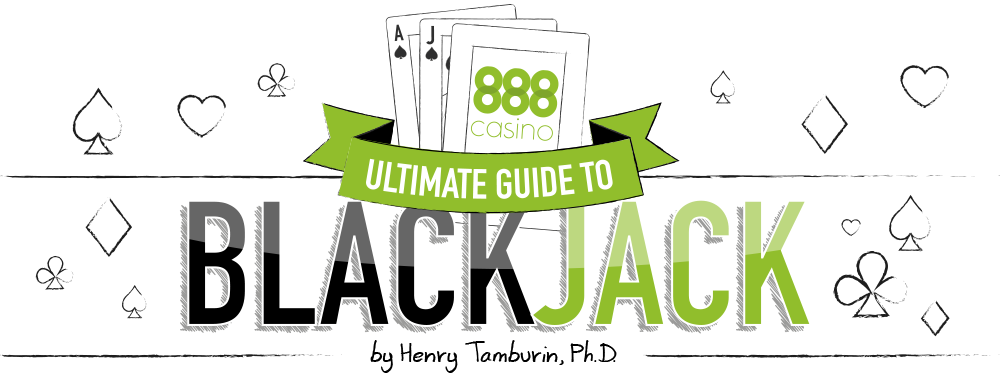
BLACKJACK CARD COUNTING

Through the first eight chapters of this guide, you’ve learned how to play blackjack and how to play every hand perfectly, regardless of the number of decks of cards or the rules. I’ve also shared with you some tips on how to boost your return even more so that you could be playing virtually even with the casino. But playing “virtually even” won’t get you the money at the end of the day; only card counting will do that.
Every time I mention the “C” word to players, their eyebrows raise and they have this bewildered look on their face that screams, “Me, card counting, what are you crazy?”
My opinion as to why I think the general public believes that it’s impossible for them to learn card counting is because:
- They have the wrong idea about what card counting is and how it works.
- Misinformation about card counting abounds in books, magazines, on the Internet, and even in TV and movies.
- These myths have been passed along from one generation to the next and they hinder players from learning how to win at blackjack.
Think I’m kidding? Do you remember this famous blackjack scene from the popular movie Rain Man? You know, that’s where autistic (actor) Dustin Hoffman is card counting at the blackjack tables at the famous Caesars Palace casino (actually filmed there) and telling his selfish brother (actor Tom Cruise) how to play and how much to bet. Cruise is winning and winning big. The scene shifts to the casino surveillance room (famous eye-in-the-sky) where two casino employees are trying to figure out how Cruise is winning all that money playing blackjack. Finally, one employee says:
“He is not catching a hole card, he isn’t past-posting, and I don’t see him using a computer. But something is not right – you know there is no one in the world that can count into a 6-deck shoe.”
Do you really have to have a photographic memory like Dustin Hoffman to be a card counter? And is it really true that “no one can count into a six deck shoe”? The quick and dirty answers to both questions are, No and No. There are other myths associated with card counting that I’ll get to shortly but for now I ask you to keep an open mind about card counting, read what I have to say about it, and then decide afterwards if it’s for you.
My goal in this chapter is to cover these points:
- Dispel the card counting myths
- Explain what card counting really is, how it works, and why it works
- Give you the details of a popular card counting system
- Show you alternative, simpler card counting systems
- Explain bankroll requirements and the all-important concept of risk of ruin.
- Give you tips on how you can boost your edge with card counting
- How to disguise the fact that you are an advantage player

CARD COUNTING MYTHS
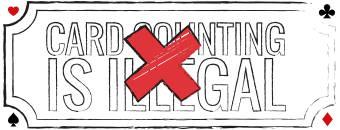
MYTH: CARD COUNTING IS ILLEGAL.
Using your brain when you play blackjack is not illegal; neither is card counting.
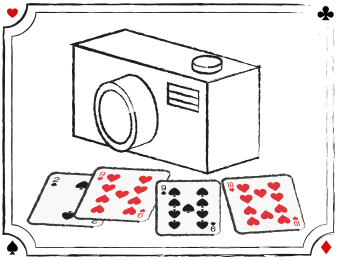
MYTH: YOU MUST HAVE A PHOTOGRAPHIC MEMORY TO BE A CARD COUNTER.
The general public believes that a card counter memorizes every card in the deck (just like Rain Man did in the movie). The fact is that card counters don’t memorize every card. What they do is assign a “tag” to specific cards (like +1 or –1), and then add or subtract the tags as the cards appear on the layout. Card counting, in fact, requires nothing more than simple addition and subtraction (in some counting systems, a little division, too).
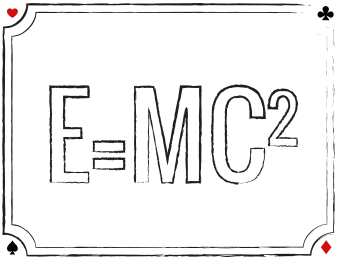
MYTH: YOU’VE GOT TO BE A MATHEMATICAL GENIUS IN ORDER TO BE A CARD COUNTER.
The movie 21 portrays card counting as an intellectually difficult task that can be learned only by top-level MIT college students with high IQs. Hogwash. If you have average intelligence (meaning you can read, write, and can mentally add and subtract), you can learn card counting.
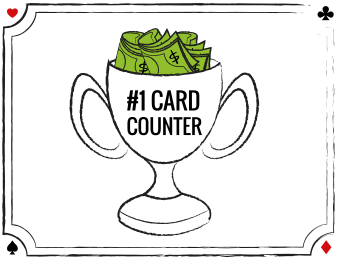
MYTH: CARD COUNTERS WIN ALL THE TIME.
Rain Man did. So did the MIT students. Don’t believe everything you see and hear in the movies. The fact is that card counters have a small mathematical edge (roughly one-half to one percent) over the casino, and even though they will win more money than they lose over time, they certainly can’t and won’t win every time they play.
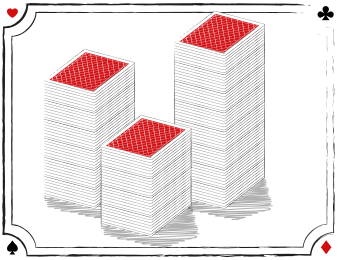
MYTH: IT’S IMPOSSIBLE TO CARD COUNT WHEN THE CASINOS USE SIX OR EIGHT DECKS OF CARDS.
Isn’t that what the casino security person said in the Rain Man movie? Yes he did, but it isn’t true. Remember that card counting is nothing more than mentally adding plus values and minus values, and you can do that with six and eight decks as easily as you can with a single deck of cards.
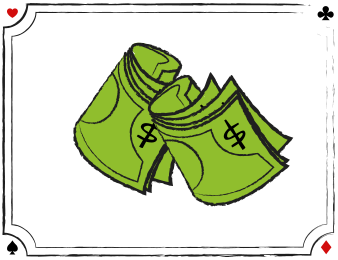
MYTH: YOU NEED A TREMENDOUS BANKROLL TO BE A CARD COUNTER.
Not so. If your bankroll is meager, you just need to play at a lower minimum bet size. What is important is that you have enough bankroll in relation to your bet size to withstand short-term losing streaks (remember, you can’t win every time you play).
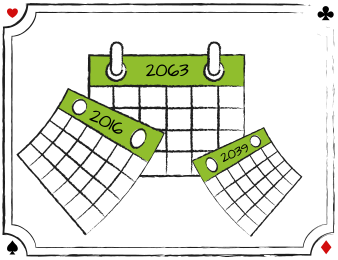
MYTH: IT TAKES A LIFETIME TO LEARN CARD COUNTING.
It’s true that older traditional card counting systems require a fair amount of time to master (but certainly not a lifetime). However, the newer systems that have been developed focus more on simplicity and ease of use, and although they may not have the same profit potential as a more complex counting system, they take only hours to learn by average players.
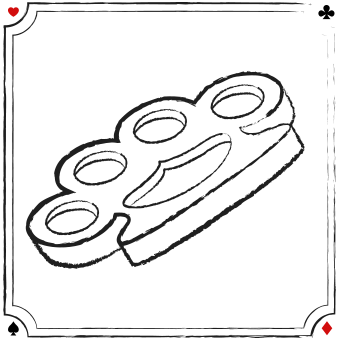
MYTH: THE CASINOS WILL KICK YOU OUT OR WORSE BEAT YOU UP IF THEY CATCH YOU CARD COUNTING.
I’d be lying if I said casinos never roughed up card counters. That has happened in the past but nowadays smart lawyers have defended abused card counters and won several high-profile cases against casinos. Casinos nowadays have become much more careful of how they treat suspected card counters. As for kicking out card counters, it’s true that in some (but not all) gaming jurisdictions, a casino can ask a card counter to stop playing blackjack (or tell him to leave the property). This is a risk that all card counters face but the key is to minimize this risk (and I’ll show you how to do this later on in this chapter).

KEY TAKEAWAYS
- There are many myths about card counting that players need to ignore and instead focus on what it really is and how it works
- Card counting is legal.
- Card counting works in multi-deck games as well as single- and double-deck games.
- You don’t have to have a photographic memory to be a card counter.
- You don’t have to be filthy rich to be a card counter.
- Card counters don’t win every time they play.
- There are different types of card counting systems; the more complex yield a higher profit potential while the simpler systems take much less time to master.
- In most gaming jurisdictions, casinos can ask card counters (or any player for that matter) to stop playing.
- Learning card counting is the key to beating the casinos at their own game.

EFFECT OF CARD REMOVAL
Picture a fishbowl containing 100 black marbles and 100 white marbles. You can bet as much as you want on which colored marble you will randomly select from the bowl. You begin by betting one dollar on a white marble. You close your eyes, stick your hand into the bowl, and randomly pull out a marble. What are the odds it will be white? Obviously, the odds are 50-50 since there are equal numbers of white and black marbles in the bowl.
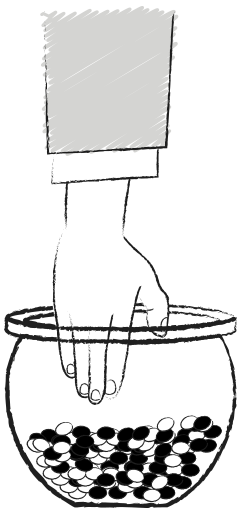
Suppose you picked a white marble on your first try. Congratulations, because you just won a buck.
We’ll set aside that white marble, and now you get to pick again. You bet another dollar on white. Pause. What are your chances of picking another white marble the second time? If you said 50-50 you are wrong. That’s because on the second pick there is one more black marble in the bowl than white. (Remember, we removed one white marble on the first pick.) The odds of picking a white marble on the second try are no longer 50-50. In fact, you would have had a half percent advantage if you bet on a black marble on your second pick (because there were 100 black and 99 white marbles in the bowl). Of course, that doesn’t mean you are guaranteed to win, because your edge is small. But if you were a smart player in this game, you would have bet on a black marble for your second pick. Furthermore, you’d track the marbles as they were selected and removed from one round to the next. There may be a point when there will be a large imbalance of black vs. white marbles in the bowl or it could swing the other way (more white than black marbles). It doesn’t matter because as long as you carefully track the balls being selected, you’ll know beforehand which marble is the better bet; and, by the way, that would be a good time to bet more than a dollar. Do you get the point of how you can “beat” this marble game by keeping track of the balls being selected to give you information going forward on which ball has the better odds of being picked?
The above game is an example of a dependent-trial process because the odds change depending on what marbles were selected in previous picks. Blackjack is also a dependent-trial process game, only it’s not played with marbles but with playing cards.

CARD REMOVAL IN BLACKJACK
Suppose you sit down at a single-deck blackjack game with two other players and during the first round after the shuffle, you notice that four aces were played. What are your chances of getting a blackjack on the second round? How much would you bet on the second round?
Because all four aces in the deck have been removed in the first round, your chance of getting a blackjack in the second round is 0; therefore, if you were a smart, observant player, you would bet the minimum in round two. (On the other hand, if no aces appeared in round one, it would have been wise to bet more money in round two because you had a greater chance of getting a blackjack and a bonus payout.)
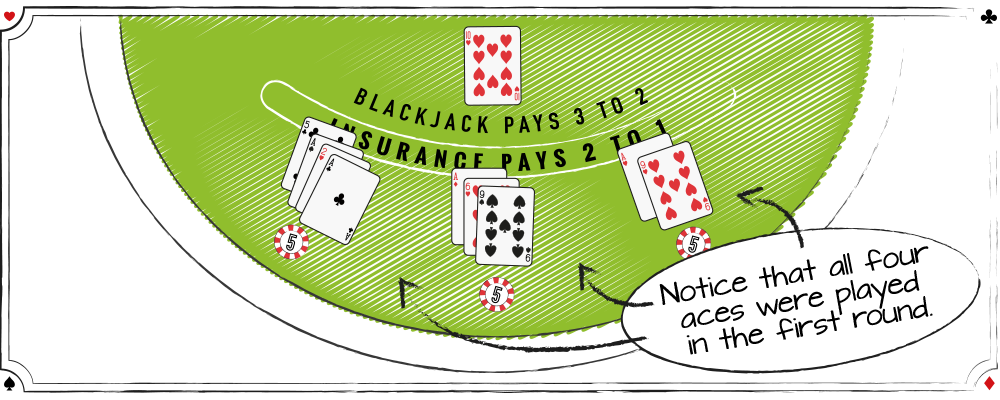
The point is this: the odds in blackjack are not static from one round to the next; the odds change depending on what cards were played (and removed) in previous rounds. The effect of removing aces is fairly obvious but what about the other cards? Do they have the same importance when taken out of play?
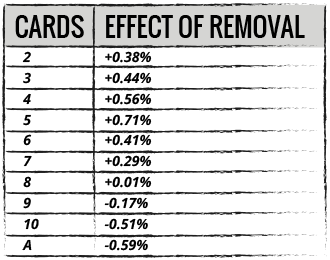
Mathematicians have studied this by simulating millions of hands of blackjack on a computer. They program a blackjack game with a specific set of rules (let’s say a single-deck game), and using the basic strategy to play every hand, they can compute the player’s expectation. They then repeat the simulation with the same rules, only they remove, say, one 2 from the deck and re-compute the player’s expectation. They can then compare the house edge with one 2 removed with the benchmark game to determine what the effect is when a 2 is removed. In fact, the table to the left shows the results from a study on the effect of card removal for a single-deck game (Table D7, Blackjack Attack: Playing the Pros’ Way, 3rd edition). It shows the approximate gain or loss (i.e., its “worth”) to the basic strategy player as each card is removed from the top of the deck in a single-deck game with these rules:
S17, DOA, NDAS, split pairs up to four hands, and split aces only once).
Notice that the removal of certain ranks has a much greater effect on the player’s expectation than others. For example, removing a single ace from the benchmark single-deck game would change the player’s expectation by −0.59% (not good), whereas the removal of a single 5 would increase the player’s expectation in this game by +0.71% (very good).
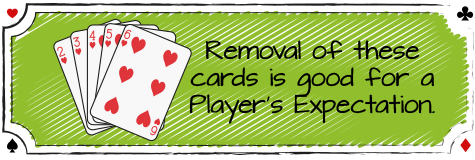
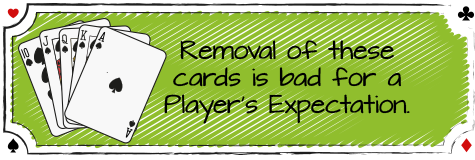
What would happen if we removed, say, an ace and a 5? To a good approximation, we can add the resulting effects of each card to determine the net effect: (−0.59%) + (+0.71%) = +0.12%. In other words, the removals of an ace and a 5 nearly cancel each other, leaving us almost right back where we started.

If you glance again at the table, you can see that the small cards all have a positive effect when they are removed from play and the 10s and aces have a negative effect. Also the removal of a 5 has a much greater effect than the removal of an 8. Any card counting system has to somehow accurately reflect the different strengths of the cards. So how did the mathematicians do this when they were developing their card counting systems? It’s actually quite remarkable what they did, and I’ll show you in the next sub-chapter how they did it.
KEY TAKEAWAYS
- Blackjack is a dependent-trial process game.
- Removal of small cards (2 through 6) has a positive effect on a player’s expectation.
- Removal of large cards (10s and aces) has a negative effect on a player’s expectation.
- Removal of some cards (e.g., a 5) has a much greater effect on a player’s expectation than the removal of other cards (e.g., an 8).
- The effects of removal of several cards on a player’s expectation are additive.
- Any card counting system has to accurately reflect the different “strengths” of the cards as they are removed from the deck(s).

HOW CARD COUNTING WORKS IN BLACKJACK
In the previous sub-chapter about the effect of card removal, you learned that:
- Removal of small cards (2 through 6) has a positive effect on a player’s expectation.
- Removal of the large cards (10, J, Q. K, and ace) has a negative effect on a player’s expectation.
- Removal of the 7, 8, and 9 has very little effect on a player’s expectation.
It’s important that you understand why the removal of small cards from the deck is player favorable, and the removal of large cards is player unfavorable. If you consider the rules and the playing strategies used by players (i.e., basic playing strategy), and the fixed house rules used by the dealer, the following conclusions can be made:

 THE BLACKJACK PAYOFFS FAVOR THE PLAYER.
THE BLACKJACK PAYOFFS FAVOR THE PLAYER.
When the remaining undealt cards are richer in large cards, you are more likely to be dealt a blackjack, and this favors the player. Even though the dealer has the same chance of getting a blackjack, a player’s blackjack is paid a bonus payoff (3 to 2) whereas the dealer’s blackjack is paid at even odds (1-1, assuming the player doesn’t have a natural also). For example, if we bet $10 and get an untied blackjack, we get paid $15 (3-2 payoff). If instead the dealer gets a blackjack, she only wins our original $10 bet (1-1). This is one reason why a ten/ace-rich deck favors the player.
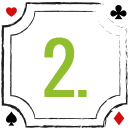 WHEN YOU DOUBLE DOWN, YOU ARE USUALLY HOPING TO GET A LARGE CARD.
WHEN YOU DOUBLE DOWN, YOU ARE USUALLY HOPING TO GET A LARGE CARD.
When we double down on hard 9, 10, and 11 per the basic strategy, we are hoping to draw a large card to give us a strong pat hand. Furthermore, most doubles occur when the dealer has a weak upcard. Therefore, you are more likely to make a pat hand and the dealer is more likely to bust with a weak upcard when the unplayed cards are richer in large cards. This is a second reason why a ten/ace-rich deck favors the player.
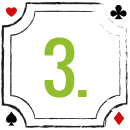 AN ABUNDANCE OF LARGE CARDS FAVORS PAIR SPLITTING.
AN ABUNDANCE OF LARGE CARDS FAVORS PAIR SPLITTING.
Many pair splits (per the basic playing strategy) will be favorable to the player when the unplayed cards are ten/ace rich. This is especially the case when splitting aces, and 7s, 8s, and 9s. This is a third reason why a ten/ace-rich deck favors the player.
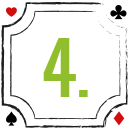 INSURANCE CAN BECOME A PROFITABLE BET FOR THE PLAYER.
INSURANCE CAN BECOME A PROFITABLE BET FOR THE PLAYER.
In Chapter 2.6, I stated that insurance was an unprofitable bet for the basic strategist and should not be made. However, when you have knowledge of the composition of the unplayed cards, the insurance bet can become profitable. Specifically, when the unplayed cards are sufficiently rich in 10s, the likelihood that the dealer will have a 10 in the hole increases, making insurance a profitable bet for the player. (You’ll learn how rich the unplayed decks need to be shortly.) This is a fourth reason why a ten/ace-rich deck favors the player.
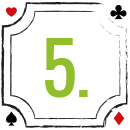 HOUSE RULES DICTATE THAT THE DEALERS MUST HIT 16 OR LESS AND STAND ON 17 THROUGH 21.
HOUSE RULES DICTATE THAT THE DEALERS MUST HIT 16 OR LESS AND STAND ON 17 THROUGH 21.
Obviously, when the deck is richer in large cards, the dealer has a higher probability of busting when drawing to a stiff 12 through 16. Players, meantime, don’t have to hit stiff hands. Moreover, when the dealer has a stiff hand and the deck is rich in small cards, the dealer is more likely to achieve a pat hand. This is one reason why a deck rich in small cards favors the dealer.
For the above reasons, it should be clear to you why small cards favor the dealer more than the player and large cards favor the player much more than the dealer.

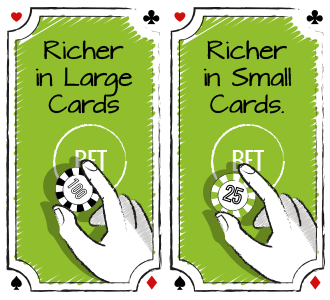
MECHANICS OF CARD COUNTING
Here’s the crux of card counting. After the dealer shuffles the cards, there are an equal number of small and large cards in the deck(s). During the play of a shoe, the composition of the unplayed cards changes. By tracking the depletion of small and large cards, card counters know when the relative composition of the unplayed cards is richer in large or small cards. When the deck becomes richer in large cards, the card counter has the edge and he bets more. Likewise, when the deck becomes richer in small cards, the card counter doesn’t have the advantage; therefore, he bets small. Mathematicians developed card counting systems as a tool that players can use to determine when they have the edge (and should bet more). The first systems that were developed assigned a value, or tag, to each card. For example, one system known as Hi-Lo assigns:- A tag of +1 (that’s “plus” one) to every 2, 3, 4, 5, and 6 ranked card (small cards) to reflect the fact that removal of any of these cards will have a positive effect on a player’s expectation.
- Likewise, the 10s and Aces group (large cards) are assigned a tag of –1 (“minus” one), because their removal from the deck(s) is harmful to the player.
- Since the removal of the 7, 8, and 9 has a much lesser effect on a player’s expectation (compared to the removal of other cards), they were assigned a tag of 0 (meaning these cards could be ignored while card counting).
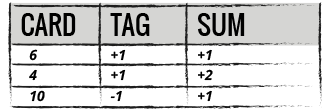
For example, suppose player #1 has a two-card hand consisting of a 6 and a 4 and then draws a 10 for a 20. A card counter would add the tags for each of the cards to arrive at the sum of +1 (again, this is known as the running count).
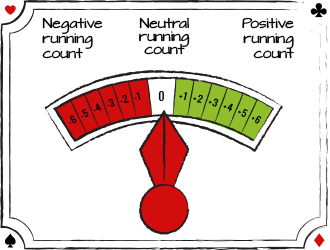
Suppose the running count is positive after the first round of play. What does this tell the card counter? In order for the running count to be a positive number, there must have been more small cards played in the previous round than large cards (remember the small cards have a tag of +1 and the big cards have a –1 tag). If that’s the case then the opposite must be true for the undealt cards; namely, they must contain more large cards than small cards.
- If your running count is positive, then the undealt cards are richer in large cards, and the card counter has the edge.
- If the running count is negative, the undealt cards are richer in small cards, and the card counter does not have the edge.
- If the running count is 0, there are an equal number of small and large cards in the unplayed cards and the deck is considered neutral (as it is at the top of a deck after a shuffle).
Card counters indirectly have knowledge of the ratio of large cards to small cards on the next deal by keeping track of all the cards that were played in the previous rounds. (I hope you are pleasantly surprised to see how card counters track cards. They aren’t memorizing every card — a myth — but only mentally adding the +1 and –1 tags assigned to each card that reflect its effect on a player’s expectation when they are removed.)
Card counters then use their count to vary their bets on the next hand as follows:
- They INCREASE their bet size when the running count is POSITIVE (because the undealt cards are richer in large cards), and
- DECREASE their bet size when the running count is NEGATIVE (because the unplayed cards are richer in small cards).
Card counters gain the upper hand over the casinos because:
- They will bet more money on positive counts (when they have the edge), and
- They will bet less money bet on negative counts (when the casino has the edge).
Here’s another point to keep in mind.
- Counters actually lose more hands than they win but they win more money than they lose, in aggregate.
How do they accomplish this?
- They have a lot more bet on the hands that they win compared to the amount of money bet on the hands that they lose. It’s that simple.
If you are still thinking, “Won’t the dealer have just as much chance to get the big cards as I will,” the answer is yes, but as mentioned earlier, players can double down, pair split, get paid 3 to 2 on blackjacks, take insurance when it’s offered, and unlike the dealer, don’t have to hit a hard 12 through 16 when the undealt cards are richer in large cards. This is what creates the basic edge that card counters have over the casino when the count is positive, and this is how card counters can beat the game of blackjack.

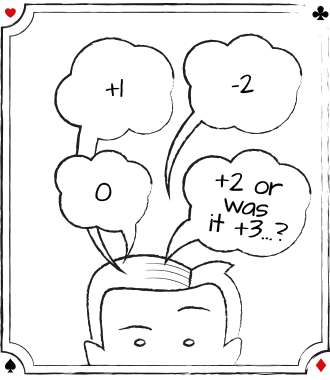
DIFFERENT CARD COUNTING SYSTEMS
For example, a Level 1 counting system (such as Hi-Lo) uses:
+1 for the small cards and −1 for the large cards.
However, from our discussion of the effect of card removal, the effect of removal (EOR) of, say, each small card (2 through 6) is not the same. The 5, for example, has a greater EOR than, say, a 2. Therefore, some card counting systems that aim for more accuracy try to incorporate this fact by assigning a tag of +2 to the ranked cards that have a greater EOR (e.g., the 4 and 5) and +1 to the other small cards that have less effect. (Likewise they will assign −2 tag to some of the large cards that have a greater effect on removal.)
There are also some Level 3 card counting systems (with some rank cards assigned a value of +3 or −3). Obviously, as the levels of the counting systems increase, the complexity of learning the system and playing it without mistakes also increases. For readers of this guide, I would recommend you begin your card-counting journey with a Level 1 system. (Although later on, I will describe a few simpler systems that are not as powerful as level 1 systems but take much less time to master.)
To give you a flavor of the different types of card counting systems that are available to players, see the table below.
(This is for information only.)
Note the tags assigned to each card, which ones are level 1, 2, or 3, and the following information for each system:
- Betting correlation (BC), used to predict how well the system predicts good betting situations.
- Playing efficiency (PE), used to predict how efficiently the system alerts a player to deviate from the basic playing strategy.
- Insurance correlation (IC), used to predict how well a counting system predicts when the Insurance bet should be placed.

Now that you get the picture of how card counting works and how it can give you the edge when you play blackjack, in the next sub-chapter I’ll explain the details of the popular Hi-Lo Level 1 card counting system. (Stay with me because it isn’t as difficult as you may think it is.)

KEY TAKEAWAYS
- Card counting involves arithmetically adding the tags assigned to cards based on their effect of card removal.
- Removal of small cards increases a player’s expectation, so they are assigned a positive tag.
- Removal of large cards decreases a player’s expectation, so they are assigned a negative tag.
- Card counters mentally add the tags of the small and large cards that they see to arrive at an end-of-round running count.
- The counter carries over the running count from one round to the next.
- Whenever the running count is a positive number, this is an indicator for the counter that he has the edge on the next round and should bet more.
- Whenever the running count is negative, this is an unfavorable situation for the counter and he bets small.
- Positive running counts are favorable for a player because he will get more blackjacks, be more successful in most doubling and pair splits, be able to take insurance when it is profitable to do so, and unlike the dealer, doesn’t have to hit a stiff hand.
- Level I counting systems assign +1 to the player-favorable cards and −1 to the player-unfavorable cards, as regards their removal from the deck.
- Level 2 (and higher levels) counting systems aim to more accurately reflect the effect certain cards have with their removal. For example, a Level 2 system may assign +2, +1, and −1 and −2 to specific cards.
- Level 2 (and higher) counting systems are slightly more powerful than Level 1but more difficult to master and use.
- The most popular Level 1 counting system is known as Hi-Lo.

LEARNING THE HI-LO CARD COUNTING SYSTEMS
This sub-chapter, and the following three sub-chapters, will teach you the complete Hi-Lo card counting system. In this sub-chapter, you will learn:
- The history of the Hi-Lo card counting system
- The tags or values assigned to each card in the system
- How to learn the tags for each card
- How to practice keeping the running count
Note: At first glance the information in this sub-chapter, and the ones that follow, may appear overwhelming to most recreational players. However, if you practice the drills outlined in these sub-chapters, you will find that the Hi-Lo card-counting system is not as difficult as it first appears to be.
HISTORY OF HI-LO
In 1963, computer mathematician Harvey Dubner gave a talk at a Computer Conference in Las Vegas in which he explained the Hi-Lo point count system that he devised. His counting system was much simpler and more practical than Dr. Edward Thorp’s previously developed Ten Count system that appeared in his best-selling book Beat the Dealer (coincidentally, Thorp was the chairman of this panel). Three years later, Thorp published a revised and expanded second edition of Beat the Dealer that included Dubner’s point count system along with a computer-optimized strategy developed by computer scientist Julian Braun (who subsequently published the Hi-Lo in his book How to Play Winning Blackjack in 1980). Several other mathematicians have studied and optimized the Hi-Lo over the years, most notably, Stanford Wong in his classic book Professional Blackjack.
Hi-Lo has been the gold standard of card counting systems for many years. It’s also the card counting system I’ve used successfully for nearly 50 years, and have taught to hundreds of players in my blackjack school and seminars. It works well, is relatively easy to learn, and it will give you the edge when you play offline or online blackjack.

CARD TAGS FOR HI-LO
As discussed in sub-chapter 10.3, the Hi-Lo assigns a +1 value, or “tag,” to every low card (i.e., 2, 3, 4, 5, and 6 ranked cards) and −1 to the high cards (i.e., 10, J, Q, K, and A). The neutral 7, 8, and 9 ranked cards are assigned a tag of 0 (i.e.,they are not counted in the Hi-Lo system).
Notice that there are an equal number of +1 cards and −1 cards in Hi-Lo. I’ll have more to say about this “balance” shortly.

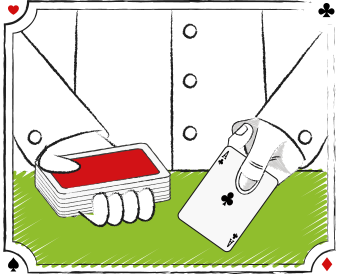
LEARNING THE TAGS OF EACH CARD
The first thing you have to master is to be able to quickly recognize the tags for each card in a deck. Here’s a simple drill that will help. Take a deck of cards, shuffle them, turn over the first card, and say whether its tag is +1, −1, or 0. (Focus only on what the tag of the card is and not on its rank.) Keep doing this drill until you can accurately recall from memory the tag of each card.
Now take the deck of the cards and repeat the above drill, only this time, add (or sum) the tags of the cards. For example, the table below shows a random sample of six cards, what the tag is for each card, and the arithmetic cumulative sum of the tags (i.e., you add 1 to your count for every low card and subtract one for every high card).
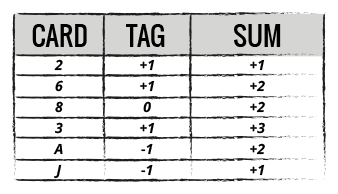
- The first card is a 2, which has a tag of +1. The sum is +1.
- The second card is a 6, which has a tag of +1. The sum is +2 [+1 + (+1) = +2]
- The third card is an 8, which has a tag of 0. The sum is still +2.
- The fourth card is a 3, which has a tag of +1. The sum is now +3.
- The fifth card is an ace, which has a tag of −1. The sum is now +2 [+3 + (−1) = +2]
- The sixth card is a Jack, which has a tag of −1. The sum is now +1 [+2 + (−1) = +1]
Speed isn’t critical right now; your goal is to practice turning over each card in a deck, and adding the tags of each card, to arrive at a final sum after you’ve “counted” all 52 cards. (By the way, if you did the drill accurately, what should the final sum be? That’s right, it should be 0 since there are twenty +1 cards and twenty –1 cards in a 52-deck of cards. Because of this fact, the Hi-Lo card counting system is known as a “balanced card counting system.” (I’ll have more to say about balanced vs. unbalanced card counting systems in Chapter 10.8.)
You need to keep practicing your card counting with a deck of cards until you can consistently obtain a final count of 0. Once you are able to do this, you need to practice “counting down a deck of cards” in 30 seconds or less (use a stop watch or the second hand on your watch). At this point in your learning curve this may seem like an impossibility, but trust me, after a little practice, you will be surprised at how quickly you will be able to count down a deck of cards. (The reason you need to practice speed as well as accuracy is because in a casino the cards are sometimes dealt rapidly by the dealer and you need to be able to keep the count accurately under these conditions.)
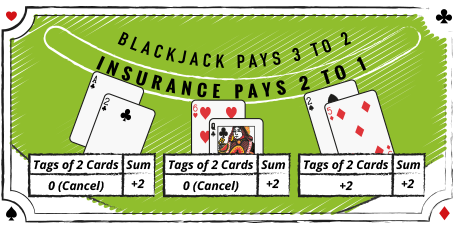
The following table shows a random round with six players plus the dealer. Assume the count is 0 to start (e.g., this is the first round after the shuffle). The second column shows the dealer’s upcard (5), the initial two cards dealt to each player and any draw cards, and lastly the dealer’s hole and draw cards. Mentally count each hand (beginning with the dealer’s upcard), and maintain the running count. After you’re done, jot down what you think the running count is.
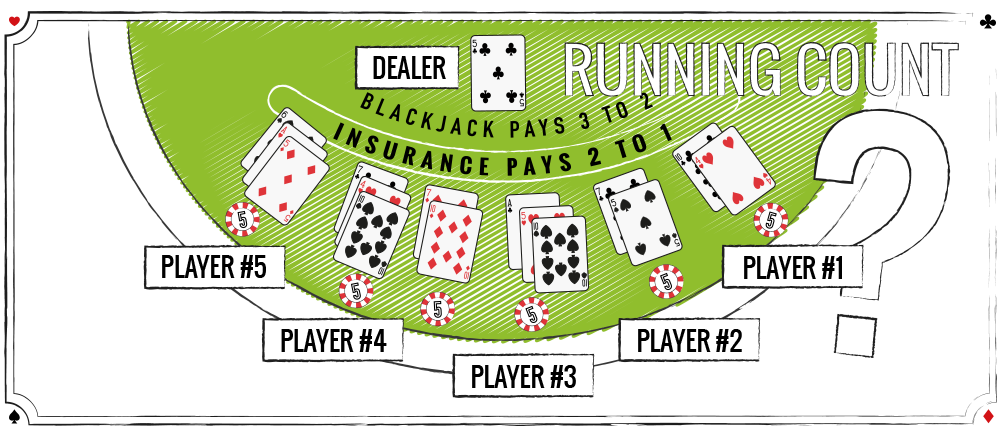
Here is the how you should have kept the running count.
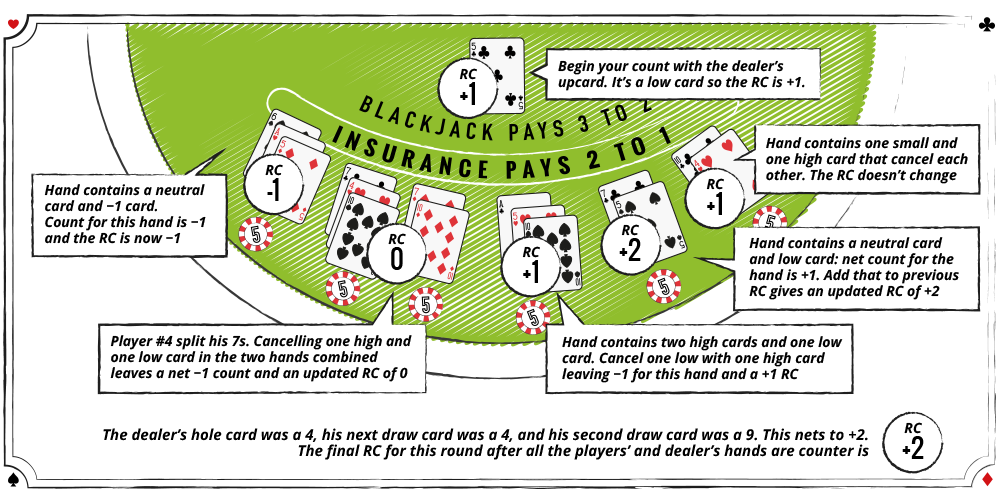
Let me pause for a moment and ask you this question. When you were keeping the running count in the above drill, what did Player #1’s hand total? I hope you said, “I haven’t a clue.” That’s because when you are card counting, your mind has to focus on one, and only one, number, and that’s the running count (and not whether player # 1 had a 14 and stood, and player #2 had 12 and stood, and the dealer had a 13 and broke). Don’t clutter your brain with useless information; instead, focus only on the important information, which is the tags (not the rank) of each card, and summing the tags to arrive at an accurate running count.

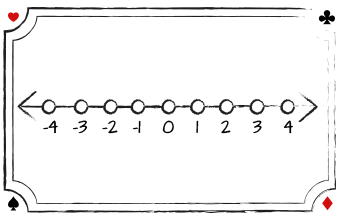
DEALING WITH NEGATIVE NUMBERS
If I were to ask you how much is 2 plus 2, I’d bet you’d be able to quickly give me the answer. But if I ask you how much is –3 plus +5 would you be able to give me the answer just as quickly? I didn’t think so. We deal with positive numbers all our lives but rarely do we deal with negative numbers; therefore, adding and subtracting negative numbers is often a challenge for players. Perhaps the following diagram will help.
For example, suppose your running count is −2 and the next card is an ace (−1 tag), your new running count would be −3. In other words, adding a negative number to a negative number gives a larger negative number (see above diagram). If your running count is −3, and you need to add a +2, your running count is now −1. (If you look at the above diagram, start at the −3 tick mark, then to add +2, move two tick marks to the right, and you arrive at −1.)
Try determining the running count for the following four hands using the above diagram as a guide.

These drills may seem hard at first but with a little practice you will be able to handle adding and subtracting positive and negative numbers accurately.

INTERACTIVE CARD COUNTING TRAINER
At this point in your learning curve I’d strongly recommend you continue practicing card counting using the Interactive Card Counting Trainer developed by 888casino. With this tool, you can practice your card counting (including cancellation) at different speeds with either a single deck or six decks of cards. The Trainer has instructions (written by me) that explain how to use the software. This is a valuable tool that will help you master keeping the running count quickly and accurately. (Tip: Don’t just practice in the single-deck mode. Try the six-deck mode so you get some practice counting six decks of cards.) Don’t be alarmed if you make some mistakes when you first try the Trainer; keep practicing a few minutes every day and before you know it, you will see how easy it is to keep a running count. Once your card counting accuracy is at 100%, increase the speed setting and repeat the drill. (You can incrementally increase the speed setting and practice your counting at progressively faster speeds.)

PRACTICING WITH NOISE
Casinos are often noisy with plenty of distractions. Once you feel comfortable keeping the running count with a deck of cards (or with the Interactive Trainer), try practicing card counting at home with the radio or TV on. That way you’ll be better prepared when you card count in the environment you will encounter in a casino. Remember your goal is to be able to consistently count down a deck of cards accurately in less than 30 seconds. Next up: How to bet using the running count.
Next up: How to bet using the running count.

KEY TAKEAWAYS
- Card counting involves arithmetically adding the tags assignedto cards based on their effect of card removal.
- The Hi-Lo card counting system assigns a tag of +1 for the low cards (2, 3, 4, 5, and 6) and –1 for the high cards (10, J, Q, K, and A). The 7, 8, and 9 is assigned a tag of 0.
- The Hi-Lo is a balanced card counting system because there are equal numbers of +1 and –1 cards per deck.
- When you count down a deck of cards using Hi-Lo your final count should be 0.
- Practice card counting with a deck of cards; cancelling the low and high cards.
- The Interactive Card Counting Trainer is a good tool to help you practice card counting.
- Simulate a noisy environment by turning on a TV or radio while you practice your card counting.
- You must continue practicing card counting at home until you can consistently count down a deck of cards accurately in less than 30 seconds.

HOW TO USE THE RUNNING COUNT TO BET IN SINGLE AND DOUBLE-DECK GAMES
Now we get to the meat-and-potatoes of card counting; namely, sizing your bets based on the running count. I’ll cover:
- How to use the running count to size your bets in single- and double-deck games

SINGLE-DECK GAMES
The good news is that varying your bets in a single-deck game is easy; the bad news is that nowadays there aren’t many “beatable” single-deck games, meaning a game that will give a card counter the advantage. The issue with most single-deck games that makes them unbeatable for card counters is twofold:
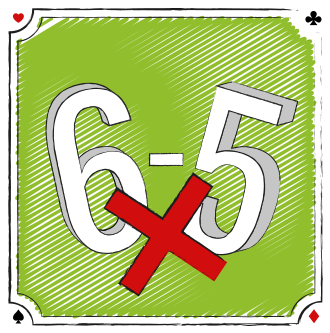
- Many single-deck games pay only 6-5 for a blackjack.
- You often get at most two or three rounds before the dealer reshuffles the cards.
As I’ve mentioned in earlier chapters, you should never play any blackjack game that pays only 6-5 for a blackjack. (Ditto if the payoff is 7-6 or even money.) The house edge against a basic strategy player zooms to over 1% in a 6-5 single-deck game, making it nearly impossible to beat even with card counting. And unfortunately, many casinos have implemented single-deck games with the 6-5 blackjack payoffs. Bottom line: Avoid any 6-5 single-deck game even if you are a card counter.
But not all is doom-and-gloom because there are still single-deck games that pay 3-2 for a blackjack (just not as many of them). However, the issue with these games has to do with how the casino reshuffles the cards in single-deck games. Let me explain. In most single-deck games, a dealer is instructed to reshuffle the cards when the number of players plus the number of rounds between shuffles equals 6 (known as the “Rule of 6”).
Rule of 6: Number of players plus number of rounds between shuffles = 6
- For example, if there are four players, the dealer knows to deal only two rounds then reshuffle the cards. (6 minus 4 players = 2 rounds.) If there are five players, the dealer will only deal only one round and then reshuffle the cards. (6 minus 5 = 1 round.) The point is this: with most single-deck games, you don’t get to play many rounds before the dealer reshuffles the cards, and those aren’t good playing conditions for a card counter. (Just think: you carefully count every card in the first round and have a juicy +6 count going in to the next round. You are all set to push out a max bet because you have a big edge when the dealer abruptly starts reshuffling the cards. Yuck.)
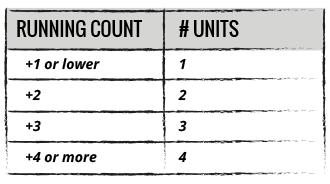
Some casinos use a Rule of 7 (better) while others use a Rule of 5 (worse). The only way to know when the dealer will shuffle the cards between rounds is to simply watch a game and see how often the cards are shuffled.
But let’s suppose you find a good “beatable” single-deck game where you get at least three rounds between shuffles. Here’s how I would recommend you size your bets.
The above is a 1−4 bet spread, where you bet the minimum of 1 unit at a running count (RC) of +1 or lower (meaning a 0 RC and all negative RC’s), and as the count rises above +1 (and you have the edge) you incrementally increase your bets. The more positive the RC, the greater your edge and the more you will be betting.
It’s easy to remember how much to bet. Whatever the RC happens to be, that’s how much you bet. For example, if your bet spread is $10 to $40, and the RC is +2, you bet $20. If it’s +4, you bet $40. If it’s +1, you bet $10.
Let me pause briefly to bring up a point that I’ll discuss in more detail in Chapter 10.11. Jumping your bets, say, from $25 to $100 from one hand to the next, especially when the $25 bet lost, is not how most gamblers bet. (They usually increase their bets after then win a hand.) So even though the running count may be +4, you will learn in Chapter 10.11 that it might be more judicious if you “chip up” from, say, $25 to $50 to stay under the casino’s radar. (That’s a term meaning playing in a manner that gives the appearance that you are a gambler rather than an advantage player.) The point is that the above betting scheme is not carved in stone. What’s important is to bet more when you have the edge and less when you don’t have the edge. (More on this in Chapter 10.11. Stay tuned.)

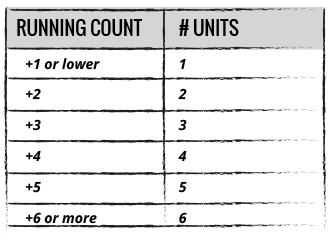
DOUBLE-DECK GAMES
For a double-deck game, I would recommend the following 1−6 bet spread.
The reason we increase the spread from 1−4 (single deck) to 1−6 (double deck) is that the casino has a slightly greater edge off the top, and to compensate for that, we have to increase our bet spread.
The same caution applies here as to the single-deck game: making big jumps in your bet size from one round to the next might attract attention from casino personnel. (Read Chapter 10.11.)

SUMMARY
You can get the edge at blackjack in single- and double-deck games by:
- Playing in games that have good rules, including a 3-2 payoff for a blackjack.
- Using the basic playing strategy for playing ever hand dealt to you.
- Varying your bets based on the running count.
When playing in a multi-deck game (six- and eight-decks), we have to add another tool to our arsenal, namely converting the running count to a true count. I’ll explain why we must do this and how to do it.

KEY TAKEAWAYS
- Use the running count to vary your bets in single- and double-deck games.
- Bet more when the running count rises and less when it is +1 or lower.
- Many single-deck games are unplayable even with card counting when a blackjack only plays 6-5 (instead of 3-2), and when not very many rounds are dealt between shuffles (i.e., Rule of 6).
- A 1–4 bet spread for single-deck games is sufficient to gain the advantage.
- With double-deck games, the bet spread should be increased to 1–6.
- Be cautious with making large jumps in your bet spreads from one round to the next.

HOW TO USE TRUE COUNT FOR BETTING IN MULTI-DECK GAMES
In this sub-chapter you will learn:- Why we have to standardize our running count in multi-deck games
- How to convert the running count to a true count
- How to bet using the true count

TRUE COUNT
Up until now, we’ve been betting based on the running count. Before I go into the details of how much to bet in a six- and eight-deck game, let me ask you this question:
- If you had a running count of +6 after the first round in a single-deck game vs. a running count of +6 after the first round in a six-deck game, would your advantage be the same in both games?
If you answered no, you are correct. A +6 running count in a single-deck game after the first round is a significant advantage for a player, justifying a larger bet size on the next hand. However, a +6 running count after the first round in a six-deck game is not nearly as significant because there are more than 5.5 unplayed decks of cards containing a lot of unseen cards. In order to get a more accurate estimate of your advantage in multiple-deck games, we need to normalize (i.e., standardize) the running count to arrive at a “true count per deck.” Sounds confusing but let me explain how this works.
Suppose you made a gallon of sweet tea and the recipe called for three scoops of sugar. Next day you decide to make four gallons of iced tea in a bigger container. How much sugar would you add? According to the recipe for one gallon, you should add 12 scoops of sugar to get the same amount of “sweetness.” Therefore, if you were to normalize the amount of sugar you added to four gallons of iced tea it would be three scoops per gallon. By doing so, the “sweetness” of the ice tea in both containers (1 and 4 gallons) would be the same.
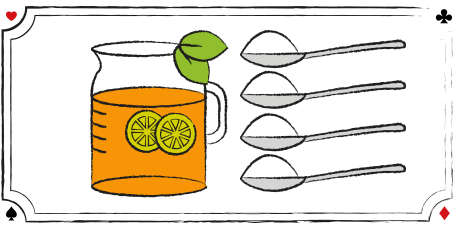
Suppose instead you added only four scoops of sugar to the four gallons of ice tea. The amount of scoops of sugar you added per gallon of tea was only one scoop, instead of three, which means the four gallons of iced tea would be significantly less sweet than the original gallon of sweet tea. By normalizing the amount of sugar per gallon of iced tea you can accurately predict the “sweetness” of the iced tea.
It’s the same concept with the running count in blackjack. In order to accurately determine your advantage in a multi-deck game, you need to convert (or normalize) the running count to a true count per deck. Stay with me and I’ll show how you how this is done. The equation to normalize the running count to a true count is:
For example, if you have a running count of +6 and there are 3 unplayed decks of cards, your true count is +6/3 = +2.
You are probably wondering how you will be able to determine the number of unplayed decks of cards. Fortunately, the casinos have provided us with a device to do this. No, it’s not the dealing shoe; it’s the discard tray.The discard tray is located on the blackjack table to the dealer’s right. (The dealing shoe is to her left; the discard tray to her right.)
The discard tray is where the dealer places the discards from each round in a neat stack that can be seen by everyone. By glancing at the stack of cards in the discard tray you can estimate the number of unplayed decks of cards by a simple subtraction.
For example, suppose you are playing in a six-deck game and the running count is +8. You glance at the discard tray and estimate four decks of stacked cards. By subtracting the number of decks in the discard tray (4) from the number of decks being used (6), you arrive at two unplayed decks (these decks are currently located in the dealing shoe). You would then mentally divide +6 by 2 to arrive at a true count of +4.
The calculation of the true count for negative running counts works the same way. If the running count in the above example were −8 with 2 unplayed decks, your true count would be −4.
Let’s try a few examples so you get the hang of this. (Assume a six-deck game.)
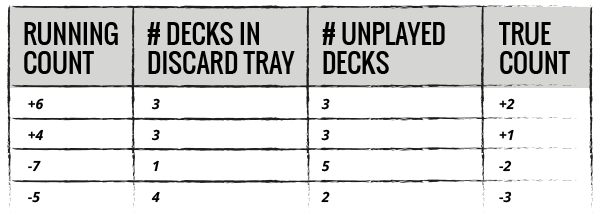
Notice that if your true count is a fraction, you should round down, or “floor,” to the next-lowest integer, to be conservative.
Therefore,+4/3 = +1.3 or +1; likewise, −7/5 = −1.4 or −2.

PRACTICING CONVERTING RC TO TC
The key to determine the true count is to estimate accurately the number of decks in the discard tray. This is how I recommend that you practice doing this.
Drill #1
Purchase 15 decks of casino-playing cards from your local casino’s gift shop or in bulk from a casino gaming supplier (such as Gamblers General Store in Las Vegas), and then prepare the following stacks of cards. (Label each stack with a sticky note.)

Now, place any one of the stacks on a table, eyeball the stack, and determine how many decks are in the stack (don’t cheat and look at your sticky note when you do this drill). Randomly place the stacks one at a time on a table, and practice estimating the number of decks in the stack by eyeballing the height of the stack. (Note: You can also purchase a discard tray from Gambler’s General Store and place the stack of cards in the discard tray — exactly how you would see them in a casino.) You need to keep practicing this drill until you can accurately determine the number of decks in a stack of cards. You’ll be surprised.
Drill #2
I will share with you another very good drill that blackjack pro Kevin Blackwood described in his book, Play Blackjack Like the Pros. Oftentimes when you eyeball the stacks of cards in the discard tray, the number of decks of cards in the discard tray isn’t going to be exactly a whole number of decks. So practice this drill (you’ll need five decks of cards for this drill and I’ll assume you have a discard tray, although that is not necessary).
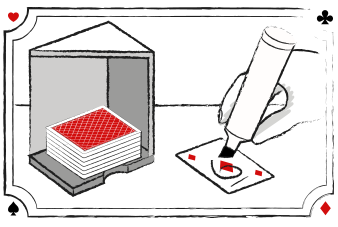
- Using a permanent marker, number the face of each card sequentially from 1 to 260. (After you number them, keep then in order.)
- Place all five decks in a discard tray, face down, with the highest number on top.
- Pick up a portion of the cards from the top of the pile and set them aside on the table. Now guess roughly how many decks of cards remain in the discard tray.
- Turn over the top card in the stack and see how close you came to your estimate (divide the number on the face of the card by 52, to determine number of decks remaining in the tray).
For example, suppose you estimated three decks in the discard tray and the number on the top card was 200. You were way off in your estimate because three decks of cards is 156 cards. You need to practice this drill until you can accurately estimate the number of decks. This is important because you are going to be betting real money based on the estimated number of decks in that tray and you want to get it right.
Drill #3
Assume a six-deck game. The second column lists what the running count is for each hand. The number of decks of cards in the discard tray is listed in the third column. Do the mental calculation to determine the number of unplayed decks in the dealing shoe and what the true count is for each hand.
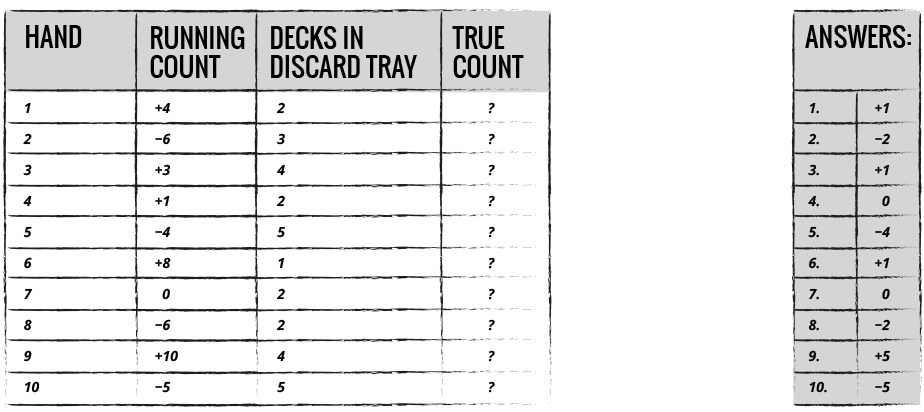
I’ve summarized below the process that you need to use to determine the true count.
- Maintain an accurate running count.
- Look at the discard tray and estimate the number of decks that have been dealt.
- Determine the number of undealt decks by subtracting the result in #2, above, from the number of decks being used in the game.
- Divide the running count by the result from #3 to estimate the true count.
Once you estimate what the true count is, you will be using it to determine how much to bet and whether to deviate from the basic playing strategy (covered in 10.7). After you’ve made your bet and played your hand, you must revert back to the running count and keep updating the running count. You only convert the running count to a true count for a split second at the start of the round to determine how much to bet (and as you’ll learn in 10.7, how to play your hand). Otherwise, you maintain the running count from one round to the next until the shuffle. At the start of the next shoe, begin your running count at 0 again and repeat the process. Note: It’s OK to round your true count down or up, to the nearest integer, but for betting purposes only. For example, if your true count is 2.4, you should round down to 2.0; but if it’s 2.8, you can round up to 3.0.

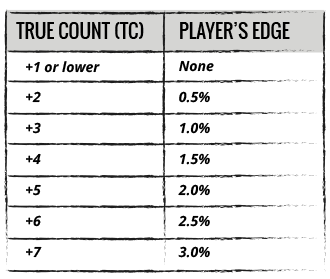
YOUR EDGE
As a general rule, for every increase in the true count by 1, the player’s edge increases by about 0.5%. Therefore, in a six-deck game with a house edge of 0.5%, the player would not have the edge at true count of +1. It’s only when the true count reaches +2 that a player begins to have the edge (it would be 0.5% at true count of +1). As the true count continues to increase, the player’s edge continues to increase.
As a card counter, you will be sizing your bets based on the true count. The more positive the true count, the greater your edge and the more you should bet. I would recommend you use the following betting scheme because it will allow you to bet a small proportion of your bankroll on any one hand (called the “Kelley Criterion,” a betting technique that maximizes your gains while minimizing the risk of going broke). Remember you edge is small and to avoid the risk of ruin, you must bet a relatively small amount in relation to your bankroll, a point I’ll cover in more detail in Chapter 10.13.

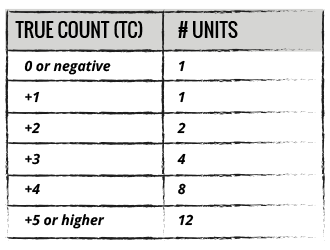
SIX- AND EIGHT-DECK BETTING SCHEME
As a card counter, you will be sizing your bets based on the true count. The more positive the true count, the greater your edge and the more you should bet. I would recommend you use the following betting scheme because it will allow you to bet a small proportion of your bankroll on any one hand (called the “Kelley Criterion,” a betting technique that maximizes your gains while minimizing the risk of going broke). Remember you edge is small and to avoid the risk of ruin, you must bet a relatively small amount in relation to your bankroll, a point I’ll cover in more detail in Chapter 10.12.
If your basic betting unit is $10, then the above bet spread would be $10 to $120. If you are a $5 player, it would be a $5 to $60 bet spread.
The above is an ideal bet spread, meaning you bet exactly according to the true count on every hand. The issue with this approach, as I mentioned in sub-Chapter 10.5, is you might attract some attention from casino personnel if you jump your bets, from, say, $10 to $80 on the very next hand (especially if the $10 bet lost). For now, keep this point in mind and in Chapter 10.12 I’ll address some betting techniques that will help camouflage the fact that you are varying your bet sizes because you are card counting. (Card counting is legal as long as you are using your mind, and not an electronic device, to keep the count. However, casinos frown on players who know how to win, and I’ll address how to deal with this issue in Chapter 10.12).
The way I remember how much I need to bet on every hand is as follows:
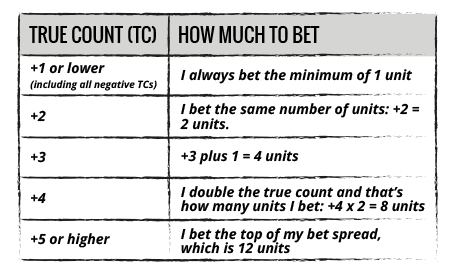
The above is a suggestion; use whatever technique works for you so that you remember how much to bet at each true count. Besides using the true count to vary our bets in multi-deck games, we can also use it to vary our playing strategy. I’ll cover this in the next sub-section.

KEY TAKEAWAYS
- In multi-deck games, you need to convert your running count to a true count to get a better estimate on how much of an advantage you have.
- True count is determined by dividing the running count by the number of unplayed decks.
- The number of unplayed decks is determined by estimating the number of decks of cards in the discard tray, and then subtracting that number from the number of decks being used in the game.
- The more positive the true count, the greater your advantage and the more you should bet.
- For multi-deck games, a 1–12 bet spread is necessary to gain a respectable edge over the casino.

HOW TO USE THE TRUE COUNT TO VARY YOUR PLAYING STRATEGY IN MULTI-DECK GAMES
In the previous sub-chapter, you learned how to very your bets in multi-deck games using the true count. In this sub-chapter, you’ll learn:- When to vary your playing strategy based on the true count
- The Index Numbers for 22 plays
- How to learn and practice the deviations from basic strategy

ILLUSTRIOUS 18 INDICES
Besides using your true count to size your bets, you can also use it to deviate from the basic playing strategy. The reason is that the more positive the count, the more inclined you will be to stand, double, split, take insurance, or surrender.
The following table contains what is known as the Illustrious 18 (for multi-deck games). It summarizes the most important hands for deviating from basic strategy (the ones that give you the most bang for your buck). (Developed by Blackjack Hall of Famer Don Schlesinger, author of the authoritative book Blackjack Attack: Playing the Pros’ Way.) The first column lists the play, the second column lists the index number, and the third column lists the action you should take on each hand.
Note: The table contains the indices for multi-deck games with s17. Where two indices are shown, the second is for h17 game. If you want the indices for single- and double-deck games, see Table 10.1 in Blackjack Attack: Playing the Pros’ Way but note that the true count estimation was to the nearest quarter-deck for single-deck games and half-deck for double-deck games.
MULTI-DECK INDICES
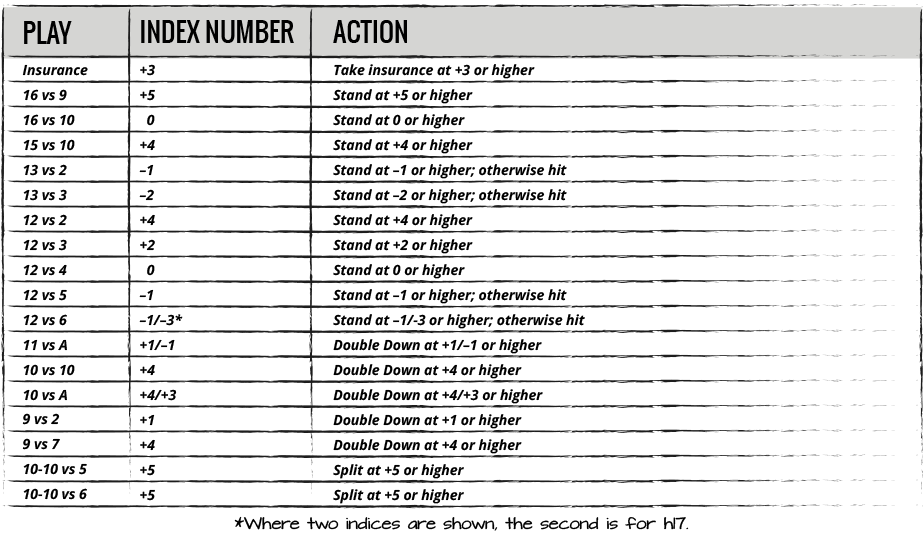
For example, suppose you have a 10-6, the dealer has a 9 upcard, and the true count is +6. The index in the above table for 16 vs 9 is +5. Therefore, instead of following the basic strategy decision to hit, you should instead stand. (This makes sense, because with a high positive true count, you are more likely to break if you hit in a ten-rich deck.)

FAB 4 INDICES
In games that offer surrender, the following table (known as the “Fab 4,” also developed by Don Schlesinger) summarizes the index numbers for surrendering the four hands listed in the table. (You surrender when the true count is equal to or exceeds the index number.)


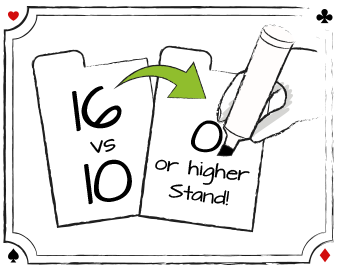
LEARNING THE STRATEGY DEVIATIONS
Drill #1
The easiest way to learn the strategy deviations is with “flash cards.” On one side of an index card, write the play and the other side the index number and the deviation. (For example, write 16 vs 10 on one side and stand at 0 or higher on the other side.) Then as you run through your flash cards, recite what the index number is and the strategy deviation. (For example, 16 vs 10, 0 or higher stand.) Keep going through your flash cards until you’ve memorized the index numbers for each play.

Drill #2
The following table lists 15 plays and the corresponding true count (multi-deck game with s17). Assume surrender is offered. Jot down how you would play each hand.
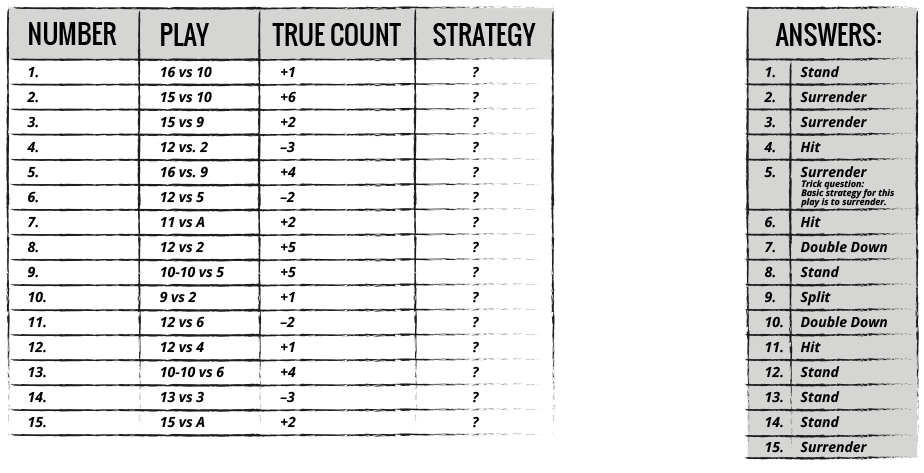

ADVANCED BASIC STRATEGY CARDS
My good friend and fellow blackjack expert Kenneth Smith has developed a unique set of basic strategy cards that have the Hi-Lo index numbers from +5 to –5 printed on the cards. There is also a set of “stealth” strategy cards that encodes the index numbers using a series of black dots in a clockwise pattern on the card (so you can use these cards in the casino when you are playing without the actual index number’s appearing on the card). You can use the set of advanced basic strategy cards (https://www.blackjackinfo.com/card/) to help you learn the index numbers for Hi-Lo (especially the ones for the Illustrious 18), and by having the stealth version handy when you play, you can refer to the card in the event you forget what the index number is for any hand.

YOUR EDGE
By following the above betting and playing strategies for single-, double-, and multi-decks games, your edge as a card counter will be about 0.5% to 1.0%. The reason I’m not being more specific about this now is because there are several other factors that will influence how great an edge you can achieve when you use Hi-Lo, and I’ll be discussing this in more detail in Chapter 10.10.(The biggest factor is the percentage of cards that are dealt between shuffles, known as the “penetration.”)

FINAL THOUGHT
If you’ve made up your mind after reading all this material about converting the running count to a true count that this is just not your cup of tea, don’t jump ship quite yet. That’s because in the next sub-chapter I’ll be explaining unbalanced card counting systems (that don’t require a conversion from running count to true count), and also several other simpler counting systems that, although not as powerful as Hi-Lo, are much easier to learn and use. Stay tuned.

KEY TAKEAWAYS
- The true count can be used in multi-deck games to not only vary your bets but also for deviating from the basic playing strategy.
- The Illustrious 18 and Fab 4 contain index numbers, which is the value of the true count where you would change your playing strategy.
- Using the Hi-Lo card counting system will give the player about a 0.5 to 1.0% edge (rules and penetration dependent).

UNBALANCED CARD COUNTING SYSTEMS
In Chapter 10.4, I explained the Hi-Lo card counting system, which is a balanced card counting system. In this sub-chapter, I’ll explain unbalanced card counting systems, specifically:- What they are
- What makes them easier to use than balanced card counting systems
- Examples of several unbalanced counting systems

UNBALANCED CARD COUNTING SYSTEMS
If you have been hesitant to learn card counting over the thought of having to do the mental division of converting a running count to a true count on every hand (Chapter 10.6), I've got good news for you. There is a new-breed of counting systems that use only the running count for betting and playing decisions. This makes card counting much easier for many players. As I described in 10.4, the Hi-Lo is a balanced card counting system because the sum of the +1 and –1 tag for all the cards in a deck net to 0. In an unbalanced card counting system, the tags do not net to 0 resulting in this important point:
- An unbalanced card counting system eliminates the need to convert the running count to a true count.
Before I explain how this can be, let me first delve into some history.

HISTORY OF UNBALANCED CARD COUNTING SYSTEM
Unbalanced card counting systems had its beginnings back in 1969 when a mathematics professor from Berkley developed an unbalanced ten count card counting system and included it in a book that he wrote (Casino Holiday by Jacques Noir, although that isn’t his real name). Other blackjack authors then began to refine his system. It was in 1983 that blackjack expert and author Arnold Snyder published the first unbalanced point count card counting system called the Red Seven Count. (That’s because the system had the same tags as the Hi-Lo with the addition of +1 tag for the two red sevens.) Snyder published the Red Seven Count in his book Blackbelt in Blackjack. Many blackjack authorities at that time (and skilled card counters, including me) couldn’t believe the power of such a simple system that eliminated the conversion of the running count to true count. However, with the advent of high speed computers years later, the unbalanced Red Seven has proven to be quite a powerful counting system without the necessity of converting a running count to a true count.

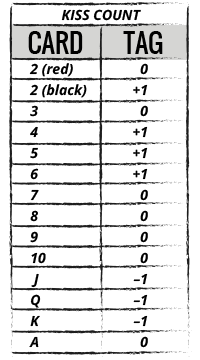
HOW UNBALANCED CARD COUNTING SYSTEMS WORK
Note: As a good friend once told me, “Don’t tell me how a clock works, just tell me what time it is.”So, the following explanation is for those that are inquisitive and want to know how unbalanced card counting systems work. It’s not necessary for you to know or understand the reason why it works to use an unbalanced system but it wouldn’t hurt if you skimmed through this section.
By way of an example, I’ll use the very simple unbalanced KISS card counting system developed by Fred Renzey (published in his book Blackjack Bluebook II). This unbalanced system assigns a tag of +1 to the 4, 5, 6, and the black (i.e., spade- and club-suited) deuce, and –1 to the J, Q, and K (i.e., the face cards). All other cards, including the red deuce, have a tag of 0.
What creates the unbalance in this system is the assignment of the tag of +1 to the black deuce, meaning if you add up the tags in a deck of cards you will arrive at a final running count of +2 (not 0 like Hi-Lo).
The starting running count in the KISS Count for a six-deck game is +10 (more about starting counts shortly). You simply add +1 to your starting count of +10 for every 4, 5, 6, and black deuce that is played and subtract –1for every face card that is played. After one-deck of cards is played, the expected average running count should be +12 (i.e., starting count of +10 plus +2 for two black deuces = +12). Suppose instead your running count was +22. You would have seen 10 more +1 cards to arrive at +22, meaning there are still 10 face card left in the unplayed five decks, or two extra face cards per card (i.e., 10/5 = 2).
Suppose you keep playing and after two decks have been played your running count is still 22. This means the unplayed four decks of cards contain an extra 8 face cards or two extra face cards per deck. If the running count stays at 22 after the play-out of the third, fourth, and the fifth deck, the number of extra face cards per deck in the unplayed decks is summarized in the table below.

The point of the above analysis is to show you that every time the running count gets to 22 (six-deck game) no matter where you are in the play-out of the shoe, you will have a “true count” of +2 (last column in table), meaning there will always be two extra face cards per deck, and you know you will have approximately a 1% edge over the starting disadvantage. (Remember the rule: for every increase in the true count by one, you edge goes up by half a percent. So at true count of 0, your edge is −0.5%, at true count of 1, it’s +0.5% and at true count 2, it’s 1.5% or 1% over the starting −0.5%,)

PIVOT POINT
All unbalanced card counting systems have what is called a pivot point. It’s a particular point where the running count is always equal to the same exact true count regardless of how deep you are in the shoe. For example, in the above example of the Kiss Count, starting with a +10 running count after the shuffle, whenever the running count is 22 you know that the true count is always +2 and you know exactly what your advantage is (at true count +2 it’s 1.5%.). In other words, the pivot is the only point where the ratio of low to high cards is exactly known, regardless of where you are in the decks.
You are probably wondering what happens when the running count drifts above or below the pivot point. Here is where some error creeps in because as you drift away from the pivot, you don’t have an exact gauge of what the true count is (it’s more of a range depending where you are in the play out of the shoe). However, the error is not very large, and over all, unbalanced counting systems give nearly the same performance as a similar balanced counting system.

DIFFERENT UNBALANCED SYSTEMS
There are several different unbalanced card counting systems. Some are Level 1; others are the more complex Level 2 and 3. Besides the Kiss Count discussed above, the following table summarizes some of the more popular unbalanced card counting systems. The data in the table also includes:
- Betting correlation (BC), used to predict how well the system predicts good betting situations.
- Playing efficiency (PE), used to predict how efficient the system alerts a player to deviate from the basic playing strategy.
- Insurance correlation (IE), used to predict how well a counting system predicts when the Insurance bet should be placed.


HOW TO USE UNBALANCED CARD COUNTING SYSTEMS
With an unbalanced card counting system, you base your betting and playing strategy solely on the running count. When the running count rises to a specific value of the running count 9whwre you have the edge), you begin to increase your bets. Below that value, you bet the minimum.
Because of concerns over copyright infringement, I’m not going to summarize the bet spreads for all unbalanced card counting systems listed above. However, I received permission from Huntington Press, publishers of the book Knock-Out Blackjack by Olaf Vancura, Ph.D. and Ken Fuchs, to describe the preferred bet spread that can be used in the K-O System for double- and six-deck games.

DOUBLE-DECK GAME
In a double-deck game, you start your count after the shuffle at –4. When the running count rises to +1, you begin to increase your bets according to the following schedule. (1-5 bet spread.)


SIX-DECK GAME
In a six-deck game, you start your count after the shuffle at –20. You begin to increase your bets when the running count rises to –4. (1-12 bet spread.)

(Note: With unbalanced card counting systems, you can customize the starting count to a positive number to avoid the use of negative numbers. For example, in the above two-deck example, you could begin your running count after the shuffle at +13 and begin increasing your bets when the running count rises to +18 or more).
Besides varying your bets based on the running count, you can also use the running count to vary your playing strategy. For example, a basic strategy player should never take insurance. But by using the K-O count, the insurance bet becomes profitable when the running count is +3 or greater. (For details on all the preferred strategy plays, consult the book Knock-Out Blackjack.)
Note: The third edition of Knock-Out Blackjack also contains .... (Don: Anthony is sending me a paragraph about the new basic strategy that was developed with K-O that eliminates indices for playing strategy. This new material will appear in the third edition of the book, which Anthony is publishing.)
You can obtain more information on the K-O Count, Red Seven Count, and Kiss Count, including preferred betting and playing strategies, from these books:
- K-O: Knock-Out Blackjack by Olaf Vancura, Ph.D. and Ken Fuchs
- Red Seven Count: The Big Book of Blackjack by Arnold Snyder
- Kiss Counts: Blackjack Bluebook II by Fred Renzey

LEARNING UNBALANCED COUNTING SYSTEMS
You can use the same drills that I outlined for balanced counting systems (Chapter 10. 4), including the Interactive Card Counting Trainer to learn how to keep the running count.

POWER OF UNBALANCED VS BALANCED SYSTEMS
There have been countless studies on the “power” of the simpler unbalanced vs the balanced card counting systems for different number of decks and rules. Suffice it to say that unbalanced card counting systems work nearly as well, and for recreational players that find the true count calculation too taxing, they ought to consider using an unbalanced counting system.

KEY TAKEAWAYS
- Unbalanced card counting systems are easier to use than balanced systems because they do not require a conversion of the running count to true count.
- The sum of the tags in a deck of cards for unbalanced counting systems is greater than 0.
- Betting and playing strategies for unbalanced card counting systems are based solely on the running count.
- The pivot point is the value of the running count that is equal to the true count so you know exactly what your advantage is.
- A small amount of error creeps into unbalanced counting systems when the running count drifts away from the pivot.
- Overall unbalanced counting systems are quite accurate and effective at giving the player the edge when they play blackjack.

ENTRY-LEVEL CARD COUNTING SYSTEMS
This chapter covers the following entry-level card counting systems that will allow the average player to either play breakeven with the casino or to have a slight edge:- Speed Count
- K-O Rookie
- Kiss Count
- Ace/10 Front Count
- Ace/Five Count

WHY LEARN AN ENTRY-LEVEL CARD COUNTING SYSTEM?
I would be thrilled if every blackjack player would learn Hi-Lo or one of the unbalanced counting systems that I reviewed in Chapter 10.8. But I’m a realist and know that for any number of reasons (and I’ve heard them all over the past 50 years) most recreational players can’t or simply won’t put in the effort to master even one of the unbalanced card counting systems discussed in Chapter 10.8. If you fall into this group, or you are a basic strategy player using a progressive betting system, let me show in dollars and cents what a simple entry-level card counting system will gain you.
In Chapter 2, I showed you how it’s possible that you could save $80,000 over your lifetime of playing blackjack if you just learn the basic playing strategy as opposed to playing your hand by hunches. I assumed a player would wager $5 million over his or her lifetime in a six-deck blackjack game. A clueless player that plays his hands by the seat of his pants stands to lose about 2% of the $5 million (or $100,000) whereas the basic strategy player (even one using a progressive betting system), facing only a 0.4% house edge, stands to lose $20,000. Now let’s see what happens to a player who learns one of the simple entry-level card counting systems I’m about to explain.

Wow! If you assume a player that learns a simple entry-level card-counting system has a modest 0.3% edge over the casino, this player stands to gain $35,000 more than the basic strategy player (and a whopping $115,000 over a clueless player). It’s also very feasible to enjoy a 0.5% edge using an entry level system, which boosts your gain to $45,000 over a basic strategy player (and $125,000 over the clueless player). Need I say any more as to why I encourage you to keep reading this chapter and setting a personal goal to at least learn one of the card counting systems I am about to explain.

SPEED COUNT
Speed Count was developed by Dan Pronovost in 2002. It’s an unconventional card counting system in the sense that it is not based on the usual metric associated with card counting systems (i.e., tracking the ratio of low cards to high cards). Instead, Pronovost developed a system based on a statistic that we’ve known about blackjack for over 60 years; namely, the average number of cards per hand is 2.71. The latter varies very little with the rules and number of decks. What Dan focused on is that in the 2.71 cards per hand, one of them will be a low card. That’s the metric he used (i.e., # low cards/hand) to develop an extremely easy system that tells you when the edge shifts in the player’s favor. Here’s how Speed Count works.
You start your Speed Count at 30 after the shuffle (double-deck game) or 27 (six-deck game). You wait until a player completes his hand and then you add one to your Speed Count for every low card (i.e., 2, 3, 4, 5, and 6) that you see. You keep adding the low cards to your Speed Count after the completion of each player’s and the dealer’s hand. At the end of the round, you then subtract the number of hands that were played in the round from your Speed Count. When your Speed Count rises to 31 or higher after each round, the advantage has shifted in your favor and you bet more. When the Speed Count is 30 or lower, you don’t have the edge and you bet the minimum.
Here’s an example of how you keep the Speed Count for one round with four players. We’ll assume a double-deck game. Our starting Speed Count after the shuffle is 30. Here are the cards dealt to each player and the dealer. (Dealer’s upcard is a 6.)
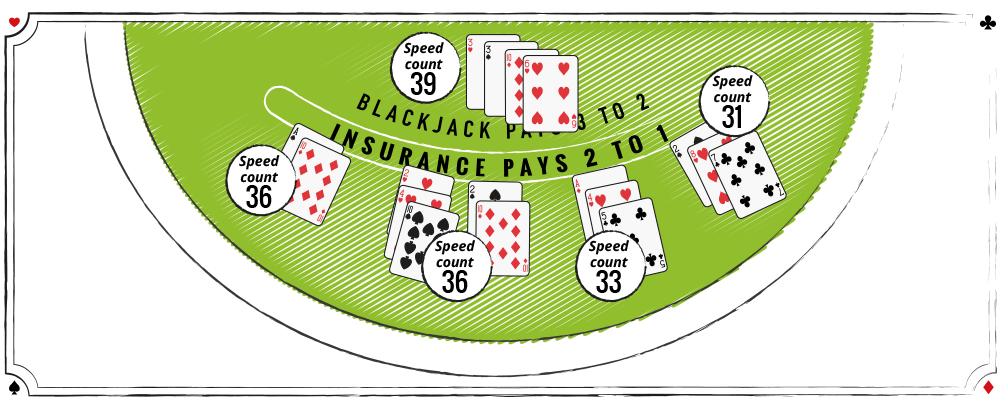
Player #1 was dealt a 2 and 8, he doubled down and drew a 7. The Speed Count increases by one due to the presence of the 2 in the hand. Player #2 was dealt a soft 15; he correctly doubled down and drew a 5. This player has two low cards in his hand (4 and 5) so the Speed Count increases from 31 to 33. Player #3 split his 2’s. On one split he drew a 4 and 10 and on the other a 10. That’s a total of three low cards in both split hands, which when added to the Speed count of 33 increases the Speed Count to 36. If you follow the same process for Player #4 and the Dealer’s hand, you’ll arrive at a Speed Count of 39. After all the players and the dealer complete their hands, and the round is over, you subtract the number of hands that were played in the round from your Speed Count (which was 6 hands, don’t forget to include the extra split hand for Player #4).
You now have a slight edge and you would bet more in the next round.
The Speed Count system also includes the Optimum Basic Strategy (OBS). This is a modified basic playing strategy that has been fine-tuned specifically to the betting with Speed Count that eliminates strategy indices. Not only does OBS boost your edge slightly over the traditional basic strategy, it also gives the player built-in camouflage to disguise the fact that he is, in fact, an advantage player. (For example, using Speed Count, the OBS states to always stand on hard 16 against a dealer’s 10 regardless of the Speed Count.)
Speed Count is simple to use because:
- You are only tracking six low cards
- You’ll never have a negative “count”
- You don’t have to do any mental divisions, just summing the low cards and one subtraction at the end of the round
- You use a fixed playing strategy for all hands (i.e., OBS)
- It gives you information when it becomes profitable to make the insurance bet, and when it’s so unprofitable that you should sit out hands or depart.
The Speed Count system includes conservative and aggressive betting spreads much the same as balanced and unbalanced counting systems sometimes do. The greater the spread, the greater the edge but the more risk to your bankroll. Depending on the rules, you can easily obtain a 0.3 to 0.5% edge with Speed Count with a conservative bet spread (you can achieve a greater edge with a more aggressive bet spread but with more risk).
For more details on Speed Count, consult the Golden Touch Blackjack Revolution e-book (www.goldentouchblackjack) or the print book Beat Blackjack Now! by Frank Scoblete.

K-O ROOKIE
This unbalanced card counting system is a simplified version of the K-O system that I described in sub-chapter 10.8. With the K-O Rookie, you use the basic playing strategy to play every hand and you make only two bets:
- A small bet when the running count is below what is called the key count (for double-deck game it’s +1 with a starting running count of −4), and
- A large bet when the running count is at or above +1.
The larger bet could be 2 units or 5 units or more (although I wouldn’t recommend more than 5 units because it might attract too much attention from the pit). If you feel you can get away with a 1-5 bet spread, you can obtain a 0.69% edge with K-O Rookie. (If you use only a conservative 1-2 bet spread, your edge decreases to 0.07%.) The system also has starting and key counts for single-, six-, and eight-deck games.
For more details on the K-O Rookie, consult the book Knock-Out Blackjack by Olaf Vancura, Ph.D., and Ken Fuchs.

KISS COUNT 1
I described this unbalanced counting system in sub-section 10.8. You only track three low cards (4, 5, and 6) and the black deuce (+1 tag), and the three picture cards (−1 tag). Summing up all the tags in a deck of cards gives a running count of +2. The system varies the starting count depending on the number of decks of cards (e.g., for double deck you start at a running count of 17 after the shuffle; with six decks, you begin with running count of 10). You bet the minimum when your running count is 19 or less and bet more when it’s 20 or more. The following betting spread is recommended: 1–6 units for double-deck, and 1–10 for six decks. The KISS Count also has rules (i.e., indices) for when to alter your playing strategy based on the running count and when to take insurance. You can achieve about a 0.5% edge with this system.
For more details on the KISS Count 1, consult the book Blackjack Bluebook II by Fred Renzey.

ACE/10 FRONT COUNT
This is another unconventional counting system developed by Fred Renzey that is probably the simplest of all systems that will get the basic strategy player to the point that he will be playing at least breakeven and perhaps with a slight edge against the casino.
The system, as described in the book Blackjack Bluebook II, is used for six-deck games. Specifically, it tells you after two decks have been played whether the unplayed four decks are richer in tens and aces, in which case you increase you bets. Here is how it works.
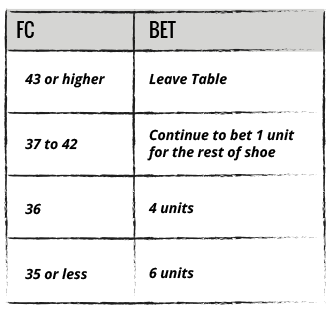
After the shuffle you simply add all the tens (including picture cards), and aces that you see during the play of the first two decks. You’ll need to eyeball the discard tray to estimate when two decks have been played (you must practice eyeballing two decks of cards at home before doing this in a casino). Once there are two decks in the discard tray, you stop adding the tens and aces. There are sixteen 10s and four aces in a deck of cards; therefore, in two decks you should see, on average, a total of forty aces and tens. According to Renzey, about 20% of the time significantly fewer than forty aces and tens will appear in the first two decks leaving a surplus of these valuable cards in the unplayed decks. That’s when you bet more.
The system recommends you use a 1–6 bet spread as follows:
There are also several recommended playing strategy changes at FC 36 and 35 as well taking insurance at 32 FC. Also, if the rules allow you to enter in mid-game, it would be wise to “front-count” the first two decks and sit down and play only if the FC is 36 or less. For more details consult Renzey’s book Blackjack Bluebook II.

ACE/FIVE COUNT
I first read about the Ace/5 Point Count system in the early 1980s in Ken Uston’s book Million Dollar Blackjack. It has since been optimized by Michael Shackleford who published his version on wizardofods.com.
With the ace/five counting system, you track only two cards – the 5, which is a dealer favorable card, and the ace, which is a player favorable card. The 5 is given a tag of +1 and the ace –1. You start your count at 0, at the shuffle, and you:
- add 1 for every 5 you see and
- subtract 1 for every ace you see.
When the deck is “plus,” it’s a player favorable situation (because there are more aces than 5s in the unplayed decks) and you should bet more. When the count is “minus,” the opposite is true; namely, the unplayed decks favor the dealer more. (This assumes that on average all the other cards in a deck will be evenly distributed.) Uston suggested using the ace/5 count in single-deck games (which were much more prevalent in 1980s than now). You would play perfect basic strategy and vary you bets as follows:
- Bet 3 units with a positive count
- Bet 2 units with 0 count
- Bet 1 unit with negative count.
Uston claimed the ace/5 count would add 0.3% edge to whatever edge you have with basic strategy. That means in most of today’s singe-deck, 3-2 blackjack games, you would be playing nearly even or with a tiny edge using the ace/5 count. More recently, gambling mathematician and author Michael Shackleford optimized the Ace/Five system for the six-deck game, specifically increasing the bet spread (1–8 up to 32 units) and changing the betting strategy so it is more effective for six-deck games. Using a 1–8 bet spread, his simulation results showed a player’s edge of 0.3%. (I wouldn’t recommend anything greater than a 1-8 bet spread; otherwise, it would attract too much attention from the pit.) You can get more details on his Ace/5 Count on his website (wizardofodds.com)

SUMMARY
I’ve summarized five entry-level card counting systems that a recreational player can easily learn and use to give him an edge over the casino (or at least play breakeven). These systems take about as much time to learn as it takes to master the basic playing strategy. Now, there is no excuse for anyone’s not taking the leap from being a gambler when he plays blackjack (i.e., someone who plays with a disadvantage against the casino) to an advantage player or AP (someone who plays with the edge over the casino).
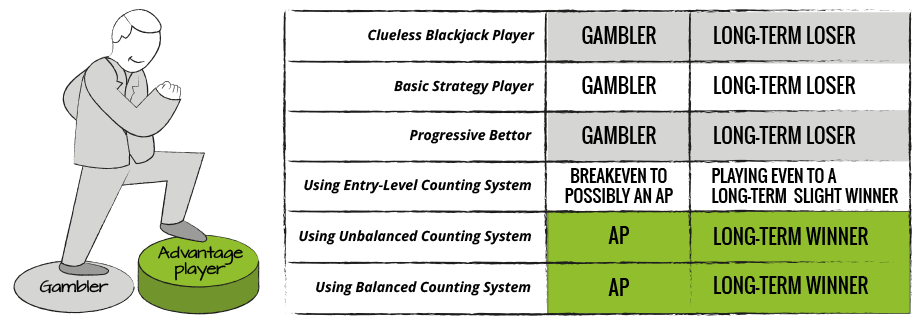
Note: The entry-level card counting systems can give you the edge but you won’t win every time you play using them. In addition, to achieve the same edge as an unbalanced or balanced counting system, you will need more bankroll to achieve the same expected return. I’ll discuss this point in more detail in the chapter on Bankroll and Risk (Chapter 10.12).

KEY TAKEAWAYS
- Entry-level systems allow the recreational basic strategy player to have the edge over the house (or at the minimum to play breakeven).
- These systems are very easy to learn but the tradeoff is, for the most part, you won’t have as much of an edge.
- Entry-level systems will convert a gambler into an AP.
- Entry-level systems can also be the first step to learning card counting.

HOW TO ENHANCE YOUR EDGE
In the previous sub-chapters I explained how you can get the edge by card counting using a balanced, unbalanced, or entry-level card counting system. What follows are some methods that you can use to enhance your edge.
PENETRATION
Blackjack dealers never deal all the cards. Most of the time they will deal out anywhere from 50% to 80% of the cards, then shuffle. The percentage of cards dealt is known as penetration.
Penetration really doesn’t matter strategy-wise for the basic strategy player but it is incredibly important for a card counter. All else equal, the deeper the penetration (meaning, the greater percentage of cards put into play), the greater the advantage to a card counter. In fact, penetration is one of the most important factors that card counters will consider when deciding whether or not to play a game.
The reasons that penetration is so important are as follows:
- The greater the penetration, the more accurate information the counter has about the composition of the undealt cards.
- The deeper the dealer deals, the greater the range of the count will be, meaning the more opportunity a counter has to bet more when the count becomes skewed in his favor.
- The rare times when the advantage for the card counter gets very high (over 4%) almost always occur at the end of shoe.

Look at it this way. At the start of a shoe, we know the count is 0 and the card counter is facing a slight disadvantage. After one round, it is rare that the count will stray very much from 0. However, as the dealer keeps dealing into the shoe, the variability of the count will gradually increase, getting wider and wider as the penetration increases, presenting an opportunity for the card counter to increase his bets when he has a healthy edge over the house (or take a break if the count becomes very negative, meaning the counter is at a great disadvantage).
The effect of penetration on a card counter’s edge has been studied via billions of computer simulated hands by countless numbers of mathematicians and the result is always the same: the deeper the penetration, the greater the edge for card counters.
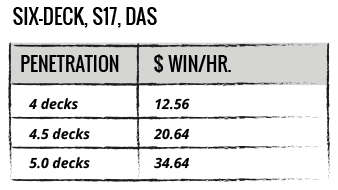
Here are the results of just one simulation study for a six-deck game with s17 and das (from Chapter 10 Blackjack Attack: Playing the Pros’ Way). The simulation was done using the Hi-Lo counting system with the Illustrious 18 (see Chapter 10.7), using a 1-12 bet spread. The first column lists the three penetrations: 4 decks, 4.5 decks, and 5 decks. The second column shows the corresponding card counter’s $ win/hour (assuming 100 hands played per hour). The game with the shallow penetration yields a $12.56 /hour win. By increasing the penetration to 4.5 decks, the win/hour jumps to $20.46 (a 63% increase). With the penetration at 5 decks (i.e., deepest penetration), the win/hour escalates to $34.61 (a 176% increase). (Note: This is why casinos never deal all the cards in blackjack; if they did, card counters would have a field day.)

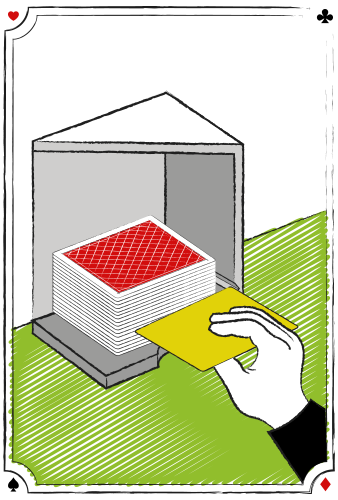
Typically, casinos will set the penetration at their blackjack games in one of two ways:
- The first is at the discretion of the dealer with some guidelines from the casino. The percent penetration occurs when the dealer places the cut card in the pack after the shuffling and player-cut is competed. Usually, casinos give dealers instructions on where to place the cut card; however, sometimes dealers have some leeway as to where they place it. If you find the latter is the case with your dealer, making a tip for her during the shuffle with a comment such as, “I’d really appreciate if you would deal more cards between shuffles cause I’m here to play some blackjack,” may encourage her to do so, resulting in deeper penetration (and a much better game).
Tip: It’s always wise to scout the tables in a casino and check where the dealers are placing the cut card before sitting down to play.
- Some casinos eliminate the variable of each dealer’s placing the cut card into the shuffled pack at different penetrations by using a notch on the side of the discard tray in a double-deck game, and a notch on the side of a dealing shoe in a six-deck game. For example, in a six-deck game (dealt from a dealing shoe), the dealer places the shuffled cards next to the shoe and then slides the cut card through the notch and into the stacked of cards, before placing them into the shoe. The notch on every shoe has been calibrated so that the penetration will be virtually the same on all tables. In a double-deck game, after shuffling and allowing a player to cut the cards, the dealer places the shuffled cards into the discard tray. The dealer then slides the cut-card through the notch in the discard tray into the stack of shuffled cards before dealing the first hand. (This is not always a bad thing because in some casinos, the notch is calibrated at 1.1–1.2 decks in a double-deck game and roughly 4.5 decks in a six-deck game. However, you need to check and confirm this via. your pre-game scouting.)
What follows is a guide to help you determine what penetration you should be looking for to enhance your edge.
DOUBLE DECK
- The penetration should be greater than 50%, ideally 60% or greater. (A 60% penetration means 1.2 decks or 62 cards are dealt.
- If the penetration is 50% or less (meaning the dealer deals one deck or less and shuffles), this game is, quite frankly, not worth a card counter’s time.
- If you are not sure of the penetration, stand to the side of the table and count the number of cards that are dealt before the dealer shuffles. (This is doing your “due diligence.”)
- Publications such as Current Blackjack News and my Blackjack Insider e-Newsletter provide information on penetration in different casinos obtained from skilled card counters/reporters.
MULTI-DECK
- In a six-deck game, you want at least 75% penetration (that’s a minimum of 4.5 decks played). Anything less is not worth your time.
- For eight-deck games, you should have at least 80% penetration (about 6.5 decks dealt).
SINGLE-DECK
As a reminder, never play any single-deck game where the payoff for a blackjack is only 6-5 (or worse even money). For the few casinos that deal 3-2 single-deck games, most use the “Rule of 6,” which gives the dealer strict rules as to when to shuffle the cards.
The Rule of 6 is as follows:
- Number of Players + Number Rounds = 6
For example, if there are three players on the table, the dealer knows to deal three rounds then shuffle (3 + 3 = 6). If there are five players, the dealer will deal only one round then shuffle.
Obviously, any game where the dealer shuffles after one round is a worthless game for a card counter. Even a two-round-and-shuffle game is marginal at best. Therefore, as a general rule, for single-deck games, you should play when there are no more than two other players (resulting in three rounds) to make it worth your while.
Note: There are instances where a casino will use a Rule of 7. The best thing to do is to observe a few rounds to check when the dealer shuffles as a function of how many players are on the table.

PLAYING RULES
You should seek out games with as many player-favorable rules as possible to increase your edge. A double-deck game, for example, with s17 and das is worth more to a card counter than one with h17 and das but with this caveat: given a choice between a game with more favorable playing rules and one that has better penetration, most of the time the deeper-penetration game is more beneficial for the counter. For example, a double-deck with h17 and das with a 1.4% penetration is more profitable for a card counter than a game with s17 and das (better rules) but with only a 1.1% penetration (shallow penetration).
NUMBER OF DECKS
As a general rule, card counters will have a greater edge with the fewest decks but that assumes all else is equal (which it seldom is). Besides the fact that the inherent edge in a double-deck game is less than it is for a six-deck game, the frequency of positive counts is always greater in the former vs the latter (meaning, card counters will have more opportunities to raise their bets in a double-deck games vs six- and eight-deck game). For this reason, I play mostly double-deck games vs. multi-deck games.
NUMBER OF PLAYERS
When the count goes positive and the counter has the edge, ideally he would like to play heads-up against the dealer so that he has the best chance of being dealt the high cards in a deck rich in tens and aces. With a table filled with players, the card counter’s chance of being dealt the high cards is diluted with the presence of other players (who are drawing from the same ten/ace rich deck). Another factor that makes playing heads-up (i.e., alone) against the dealer favorable for a counter is that the number of hands dealt per hour increases. Remember, card counters have the edge, so the more hands that they play per hour, the greater will be their hourly win rate.

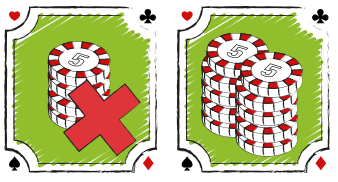
BET SPREADS
You can’t beat a six-deck game with a 1-4 bet spread no matter how good a card counter you are. The key to getting a reasonable edge, especially in multi-deck games, is to use a larger bet spread. The greater the spread, the greater the edge but also the greater the amount of attention that may come your way, and the more bankroll you will need. Nevertheless, you should use the recommended bet spreads summarized in sub-chapters 10.5 and 10.6 for different games.
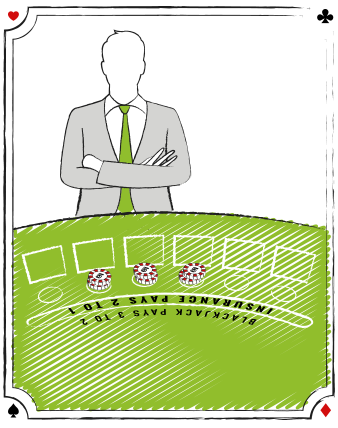
SPREADING TO MORE HANDS
Here’s a technique I use when playing a double-deck game. After I’ve been playing for roughly an hour and about ready to end my session, I wait until the count sky rockets toward the point where I’m fairly confident the next round will be the last one before the shuffle. (I get this information by either glancing at the stack of cards in the discard tray or the pack of unplayed cards that the dealer is holding in her hand.) Prior to the last round before the shuffle when the count is very positive, I’ll stand up and spread to three hands, making big bets on all spots. Whatever happens on that last round, I leave the table.
The advantages to spreading to three hands are:
- The dealer will be dealing more cards in that last round due to my spreading to three hands, resulting in a much deeper penetration for a double-deck game. This is a very good situation for a card counter.
- Spreading to three hands also allows you to get three opportunities at getting those tens and aces when the unplayed cards are loaded with them (and, sometimes, one or more blackjack hands with those big bets paying 3-2).
When I execute this ploy, it’s usually accompanied by a comment, such as,“My wife is waiting for me and this is my last chance to get even.”(More on this ploy in sub-chapter 10.11.)
BACK COUNTING
This strategy was made famous by blackjack Hall of Famer Stanford Wong (hence, this technique is often referred to as “wonging”).Back counting involves counting down a game as a spectator and then when the count goes positive, entering the game with big bets. When you think about this technique, it’s the ideal way to play blackjack since you make bets only when you have the advantage.
I used this technique early in my card counting career (along with team play, which I’ll cover next) and it was extremely profitable.Unfortunately, casinos nowadays post signs on most of thei r high-limit games that state “No Mid-Shoe Entry, ” meaning that if you attempt to enter a game after the first round you are not allowed to play until after the next shuffle. There are some variations to the No Mid-Shoe Entry that I’ve encountered in some casinos.
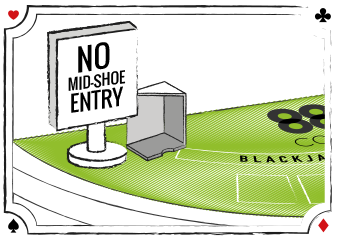
They include:
- If you play one spot after a shuffle and then decide to spread to two (or more spots), some casinos will not allow you to do so because of the “No Mid-Shoe Entry” rule.
- Some casinos will allow you to enter mid-game but restrict you to making the minimum bet until the shuffle.
- If you find a casino that doesn’t restrict you from entering a game, I would highly suggest you sit out a few hands when the count goes negative. (Obviously, you can’t do this over and over in the same session. Check out my tips on how to get away with siting out a few hands in sub-chapter 10.11.)

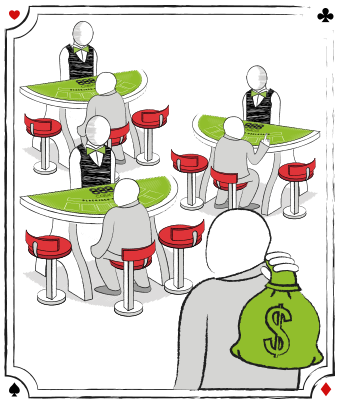
PLAYING WITH A TEAM
This is a powerful strategy used by card counting teams. Here’s how it works.
- You form a team with several other players that you know are good skilled card counters, are honest, and can be trusted (the latter is very important).
- Each member of the team puts up his/her share of the bankroll.
- Card counters known as “spotters” would play on different tables, making minimum bets, and when the count becomes positive would signal in the Big Player (BP), who enters the game and fires away with big bets.
- When the count tanks, the spotter signals the BP to exit the game; then, he or she would wait for a signal from another spotter to enter another game.
This method of play reaps enormous benefits:
- BP’s make large bets only when they have the advantage.
- BP’s reap the benefits of positive counts from several tables.
- BP’s don’t have to make a long series of minimum bets while waiting for the count to go positive.
- Having more than one BP will reduce the fluctuations and increase the BP’s profits. (Blackjack Hall of Famer Don Schlesinger calculated a 76% increase in profits by adding just one spotter.)
Casinos defense against team play is to post No Mid-Shoe Entry signs at their tables, which basically prevents the BP approach to team play. However, an alternate strategy to the BP is to just have several team players playing on different tables, each one playing with the team’s bankroll. This approach is also very profitable. There are other benefits of team play, such as the motivational support you get from other players, especially when you have a really bad session; the reduction in variance; practicing together and watching the improvement in each player’s skills; and probably the most important benefit, being able to win a lot more money with less risk than playing solo. Here’s an example of the latter.
If you play solo with a $10,000 bankroll your earning potential is far less than if you put in $10,000 and nine other players do the same so that the team has a $100,000 bank. With ten players each playing with a $100,000 bankroll, the number of hands per hour goes up dramatically compared to playing solo, and your risk of ruin is less.
There are other types of team play too numerous to describe in this Guide but I think you get the idea of how they work. But here’s one that my wife and I used long before team play became popular. It was in the late 1970s when casino gambling was first legalized in Atlantic City that we used this team ploy. The first casinos that opened had great games with great rules (including early surrender) and great penetration (that was mandated by the Casino Control Commission, meaning casinos couldn’t position the cut card anywhere they wanted to). Furthermore, the casinos couldn’t bar skillful players. To take advantage of these tremendous playing conditions, my wife and I formed a mini-team. Here is how I described it in my book Blackjack: Take the Money and Run.
“My wife sat at first base and played perfect basic strategy. After a few minutes I’d come to the same table and generally sit away from her, never giving any indication we were a married couple. I kept the count and always made a minimum bet. When the count became positive, I signaled her to increase her bet. She is talking, having a good time, and not watching the cards on the table like a card counter would do. Between the two of us, we were able to make very large bets when we had the edge in a manner that drew no suspicion from the floor supervisors.”
Playing on a team has its disadvantages. You’ve got to have a strong team leader, team rules that everyone will abide by especially when it comes the time to compensate players on the team, and, most importantly, players that you trust, not only with your money, but with their ability to play and count accurately. You also have to be sure that the games you select to attack are in fact beatable. (Pre-game scouting is a must.)
(If you are interested in team play, I would strongly suggest you read Chapter 32 of Rick Blaine’s Blackjack Blueprint, and Chapters 11 and 12 in Don Schlesinger’s Blackjack Attack: Playing the Pros’ Way.

EXIT STRATEGY
You can improve your edge as a card counter if you avoid making bets in negative counts. I’ve already discussed one way to do this (back counting), but here’s another way. When I’m playing a double-deck game and the count is negative after close to one-deck has been played, it’s unlikely the count will turn positive prior to the shuffle. Therefore, I do one of the following to avoid betting when I don’t have the edge:
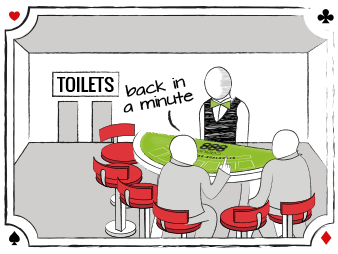
- I simply sit out hands, making an excuse that I’ll wait until the shuffle to start playing again. Surprisingly, I’ve been able to do this many times during a session without a lot of heat from the pit.
- Take a bathroom break. Just tell the dealer you’ll be back in a minute and ask her to put a lammer on your betting spot. (I suggest you also take your chips with you.) Time your break so you return right after the shuffle.
- Step aside from the table and pretend you are making a call on your cell phone and reenter the game when after the dealer completes the shuffle. (Note: Before you use this ploy, check that there is cell phone service in the room.)
- Just leave the table and play on another table. (I usually do this if the count is very negative roughly three-quarters of the way into the first deck.)
In a six-deck game, I usually exit when the true count is −2 or worse at the halfway point through the shoe. You’ll have a longer time to wait until the shuffle; therefore, I usually exit and play on another table.
The point of these exit strategies is to minimize the number of bets you make in negative counts (which in turn will increase the frequency of bets you make in positive counts and will increase your overall edge.) This is an important way to boost your edge, especially in six-deck games.

KEY TAKEAWAYS
The following techniques will enhance a card counter’s edge.
- Playing games with deep penetration.
- The penetration should be greater than 60% on a double-deck game.
- The penetration should be at least 75% for a six-deck game.
- The penetration should be at least 80% for an eight-deck game.
- In a single-deck game, you want to have at least three rounds between shuffles.
- Only playing games that have a good mix of player-favorable rules.
- Playing with the smallest number of players.
- Using an aggressive bet spread to take advantage of positive counts when they occur.
- Spreading to more than one spot.
- Back counting games then jumping in on positive counts.
- Playing with a team of card counters.
- Using an exit strategy to avoid betting in negative counts.

CASINOS' COUNTERMEASURES AGAINST CARD COUNTERS
Even though card counting is technically legal (if you only use your brain), it is frowned upon by casinos. In this sub-section, I’ll describe the techniques that casinos use to discourage card counting, and how and what they do when they catch a card counter.
DISCOURAGING CARD COUNTING
Here are some techniques that casinos use to discourage card counters.
- Using continuous shuffling machines (CSM). (See Chapter 6.1 for a discussion on this.)
- Using multiple-decks of cards with shallow penetration
- Paying only 6-5 for a blackjack on single-, double-, and multi-deck games
- Offering poor rules, such as h17, NDAS, and doubling only on hard 10 and 11
- Prohibiting mid-shoe entry
Probably the biggest deterrents for card counters are the 6-5 payoffs on blackjack and the shallow penetration.

HOW THEY CATCH INDIVIDUAL CARD COUNTERS
Casinos use some or all of the following techniques to catch suspected card counters.
- They watch a player’s bet spread, especially if he is winning. (They know card counters bet small when they don’t have the edge, and big when the edge shifts in their favor.)
- They watch how much a player bets after the shuffle vs. toward the end of the shoe. (They know card counters bet small after a shuffle because they don’t have the edge, and usually make bigger bets when the game progresses and they have the edge.)
- They watch if a player changes his bet after a push. (Most gamblers leave the same bet out; card counters, on the other hand, often change their bets depending on what happened to the count after the previous round was completed.)
- They watch how the player plays his hard 16 against a dealer’s 10. (They know that card counters will stand on 16 when they have a big bet on the felt and hit when they bet small.)
- They watch how much the player has bet on the hand when he takes insurance. (They know card counters take insurance only when they have a big bet on a hand, because the count was very positive.)
- The floor supervisor will call surveillance and have them watch how the player plays his hands (e.g., does he know basic strategy), and how much he bets. Sometimes the casino has software that allows the surveillance technician to input the cards and bets made by the player, and the software will compute if the player is varying his bets and the play of the hands in accordance with the count.
- Some casinos use facial recognition software to determine if the player is a known card counter. The casino will take a photo of the player and compare the facial features against a data base of known card counters (and cheaters).
- Most casinos have an in-house data base of known card counters (photos and other information) that they have collected or obtained from other casinos, and they will compare this data with that of the suspected card counter.
- Some casinos hire card counters to catch card counters (although this practice is not as popular as it once was).
- Sometimes a casino will archive a player’s play (via the surveillance video), and then carefully analyze it a later date to determine if the player was card counting.
- Some casinos hire a third party consultant who can analyze and confirm that the player is a skillful card counter (either with a live feed or with tape of the player playing).
- Pit personnel will watch the player’s eyes to see if he is paying close attention to the other players’ hands or staring at the discard tray, to ascertain how many decks have been played.
- Pit personnel will watch the player’s demeanor, specifically is he always serious; is he talking to other players and the dealer, does he show any emotion when he loses a big bet; does he tip the dealer; does he order an alcoholic beverage, is he stoic when he plays.

SOME ACTIONS TAKEN BY THE CASINO AGAINST CARD COUNTERS
Once a casino has surmised that the player is card counting, they will initiate any of the following actions:
- The floor supervisor will come to the table, and for no apparent reason, tell the dealer to immediately shuffle the cards.
- When the player makes a large bet, the floor supervisor will remove the cards in the discard tray and check to see if they contain an abundance of small cards.
- When the player makes a large bet, the floor supervisor will tell the dealer to shuffle the cards.
- The floor supervisor will tell the player that he is allowed to flat bet only.
- The floor supervisor will tell the dealer to move up the cut card (much shallower penetration).
- The floor supervisor will change the playing rules, increase the number of decks, or reduce the betting limits for the entire table.
- Casinos will preferentially shuffle, meaning that when the deck is player favorable they will tell the dealer to shuffle. (Yes, that means the casino is card counting; preferential shuffling is a hot topic in legal circles since it hasn’t been tested in the courts yet.)
Note: If any of the above casino countermeasures occur when you are playing, my advice is to say nothing, leave the table, and head for the exit. Do not cash out your chips because casinos often get good mug shots at the casino cage. (You can come back to the casino later to cash out or have someone else cash out your chips.)

ULTIMATE CASINO COUNTER MEASURE
Since casinos are private (not public) enterprises, they have the right to refuse service to anyone; however, they can’t discriminate because of gender, race, religion, disability, or any other civil rights protected under the Constitution. Unfortunately, using your brain to play blackjack isn’t a right protected by the Constitution; therefore, casinos can exclude any player for any reason or no reason at all. It’ s important that you understand the difference between being “barred,” or “trespassed,” and being “backed off .”

BACKED OFF
When a casino supervisor (alone) tells you that you can’t play any more blackjack, and pushes your chips that you have in the betting spot back to you, this is a not-so-subtle hint to hit the road.
Being backed off is a risk that every card counter has to accept; however, the key is to play in a manner that reduces this risk. (I will cover this in the next sub-chapter).
If you’ve been told you can’t play blackjack anymore, don’t make a fuss (this is very important). Just pick up your chips and head for the exit. (Do not go the cashier cage to cash out you chips.)
Should you return to a casino that recently backed you off? I’ve done this several times in my playing career (after waiting at least six months before I returned), and I’ve never had an issue; however, a friend of mine wasn’t so lucky. He returned to a casino that had a juicy double-deck game exactly six months after being backed off. After settling in at a blackjack table (I was playing at a different table), it wasn’t long before a floor supervisor told him politely to get lost.
My recommendation if you have ever been backed off is to keep notes of what happened; specifically, the name of the casino, what shift it was, and the name of the supervisor who backed you off. If you ever return, be sure it’s on a different shift, and be sure the same supervisor is not working that shift.

BARRING
Being barred is more serious than being backed off. When a player is barred, it’s usually done by the shift or casino manager in the presence of a casino security guard. Often (but not always) the supervisor will read a statement that basically says you are not only barred from playing blackjack but you are no longer allowed on the premises, and if you return, you will be arrested for trespassing. Nowadays, if you are barred from a casino that is owned by a large corporation (e.g., Harrah’s, MGM) that owns many casinos, you can expect that the other casinos within the corporation have received a “flyer” on you, meaning if you try to play blackjack at these other properties, they will immediately ask you to leave.
Fortunately, I’ve never been barred from any casino (backed off, yes) but I have friends that have been. Usually, casinos don’t bar nickel players; they focus more on the green, black, and purple chip players since they are much more of a threat to their bottom line. Therefore, if you are a high-stakes player, you need to be much more careful when you play to avoid detection. (Read the next sub-section for details).

CATCHING CARD COUNTING TEAMS
Casinos are well aware of the threat that a well-financed team of card counters can pose to their bottom line. They know card counting teams use signals, play in groups, have a BP that jumps from one table to another, and that often the team plays together at other casinos.
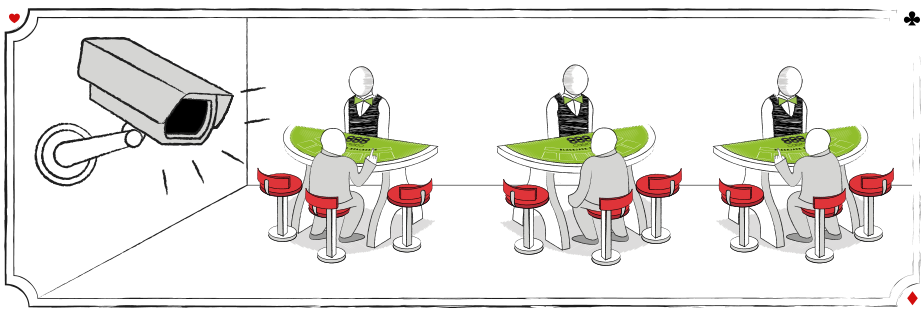
Therefore, casinos:
- Train their surveillance staff to look for players who appear to be signaling other players.
- Carefully monitor any player who walks up to a table, makes a series of large bets, then leaves.
- Check with other casinos if the same group has played there together (especially more than once).
- Watch to see if the suspected members of the teams meet up anywhere within the casino (restaurant, parking garage, etc.).
- Check their data base of known card counters to see if any of the suspected team members match.
- Dispatch a paid card counter to the casino floor to observe how the team players are playing.

PLAYER RIGHTS
Sometimes a casino will “backroom” a player, meaning they will detain, question, and sometimes harass a card counter in a back room. Once there, casino personnel have been known to rifle through a player’s wallet, make copies of their driver’s license or other identification, confiscate a player’s chips, and even threaten the player. (Note: This is not so commonplace in today’s modern casino but historically has occurred.) Legally, casinos are not allowed to question and detain a customer unless they have evidence that the patron has broken the law (such as cheating), and they are awaiting law enforcement to arrive to arrest the customer. If a casino employee asks you to accompany him to the office, you have the right to refuse (unless you are being held for a crime that you committed). Here are some tips on what you should or shouldn’t do if this happens:
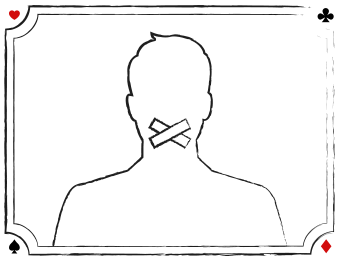
- Don’t admit that you are a card counter
- Don’t let them take your picture (if possible)
- Don’t start an argument
- Don’t show your identification
- Don’t touch any casino employee
- Act politely at all times
- Keep saying loud and clear that you are being “illegally detained” and head straight for the exit
(Note: In the event you are still coerced and brought to the “back room” and detained, my advice is to get the names of everyone involved and then contact a lawyer who has experience in successfully defending card counters. I can recommend Robert Loeb (co- author of Blackjack and the Law) and Bob Nersesian (author of Beat the Players and The Law for Gamblers: Legal Guide to the Casino Environment, spring 2016 publication).
I hope I haven’t frightened you into thinking twice about learning to count cards; however, I think it is important that you know the history of the casinos’ countermeasures against card counters and what your rights are. In the next sub-section, I’ll give you some tips on how to disguise the fact that you are a skillful card counter so that you can play under the casinos’ radar.

KEY TAKEAWAYS
- Card counting is legal as long as you are using nothing more than your brains to keep the count.
- Card counting is frowned upon by casinos.
- Casinos discourage card counters by using continuous shuffling machines, paying 6-5 on blackjacks, and offering multi-deck games with shallow penetration.
- Countermeasures used by casinos to harass a suspected card counter include shuffling the cards, lowering the maximum betting limit, restricting the player to flat betting, changing the playing rules, and preferentially shuffling.
- When a casino “backs off” a player, it means they want the player to cease playing blackjack.
- When a casino bars a player, this is more serious since it involves asking the player to leave the premises, and if he returns, he can be arrested for trespassing.
- Unless a casino has evidence that a player has committed a crime, they have no right to coerce a player into an office (or back room), question him, and detain him.
- There are lawyers who defend the rights of players who have been abused by casinos.

HOW TO DISGUISE YOUR SKILLS
One warm evening in Las Vegas, a young man was walking on the famed Strip, contemplating what had just happened. He was a good card counter, he could count down a deck of cards accurately in 20 seconds flat, and knew his strategy deviations cold. At his level of skill, he had nearly a 1% edge over the casinos, meaning he was capable of winning more than he would lose over his lifetime of playing blackjack. Yet, moments earlier, he had been barred from playing. An experienced professional card counter told him several days later, “Son, you know how to beat the game but you haven’t learned how to beat the casino.” I know the facts of this story so well, because I was that young man.

I learned a lot from that incident, not the least of which is that if the casinos don’t let you play, it doesn’t really matter how well you play. I learned the importance of disguising my card counting skills, which I’m about to share with you.
Note: Disguising your playing skills is imperative if you are card counting in a land-based casino. If you are playing an online casino where the cards are shuffled after every hand, card counting is useless (see Chapter 14).

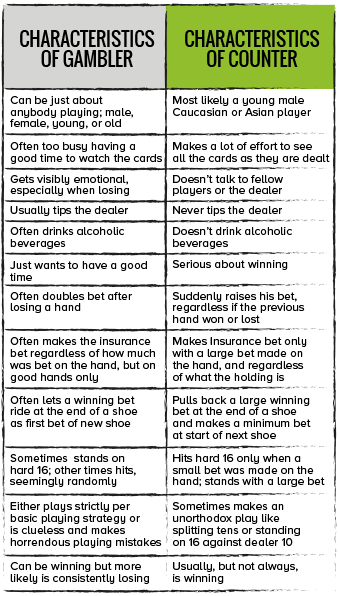
CAT AND MOUSE GAME
Casinos do not like to lose money; they prefer to cater to players who know how to lose, rather than to the very small minority that know how to win. They know that card counters have the edge over them, and as I discussed in section 10.10, they will implement countermeasures up to, and including, barring or excluding skilled players from playing. Therefore, your goal is to put on an “act” when you play that keeps you under the radar of the watchful eyes of the casino floor supervisors and surveillance personnel. Over the years, casino bosses have developed a stereotype of a card counter. What follows is their perception of the characteristics of a card counter vs. a typical gambler.
Casinos don’t need hard evidence that you are a card counter to begin to take countermeasures; they only need to suspect that you a card counter. Therefore, your first goal, if you want longevity as a card counter, is to try to emulate the above characteristics of a gambler when you are playing. By doing so, you will give the perception that you are an unskilled player, and your play will not draw attention to the ever-present pit bosses.
What follows is a smorgasbord of tips on how to stay under the casino radar. Some of the tips will make you appear like an idiot (I call these the “dumb acts”); others will peg you as a clueless player. Unfortunately, as a skilled card counter, you need to check your ego at the door when you enter a casino and take on the role of a typical unskilled recreational gambler (when in reality, you are an advantage player with an edge over the casino).
I don’t expect you to use all of the following tips every time you play; it’s sufficient to implement a few of them that you feel comfortable using to give the perception that:
- You are a recreational gambler
- You are not very skilled at blackjack
- You are out to have a good time, not to win

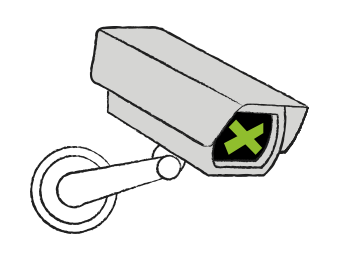
TYPES OF CAMOUFLAGE
There are two types of camouflage techniques; some are punitive (meaning there is a cost attached to them), while others are not punitive. I prefer (and use) mostly the non-punitive camouflage tactics when I play, so I’ll discuss them first.
NON-PUNITIVE CAMOUFLAGE
This involves putting on an act that gives the casino bosses the perception that you are a typical recreational gambler. These ploys cost you nothing (or in some cases, very little) and can give you longevity as a card counter when you use them. (Note: Some of them involve an encroachment of blackjack etiquette and/or casino playing rules; you will be chastised by the dealer when you implement some of these ploys but that’s actually good because it only accentuates even more the persona you are trying to create.)
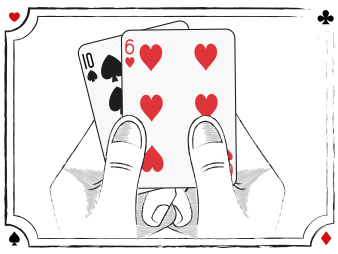
- Give the perception that you are not an experienced player by making one or more of the following gaffes when you place a bet or hold your cards:
1. In a single-deck game, hold the cards with both hands (that’s a no-no and the dealer will tell you to hold the cards with one hand only).
2. In a hand-held game, hold the cards below the level of the table (that’s another no-no).
3. When the count is high and you want to increase you bet to say, $100, instead of placing one black chip in your betting spot, stack a rainbow of different colored (i.e., denomination) chips in your betting spot, making sure to place a small denomination on the bottom of the stack and a large denomination chip on the top (that’s another no-no; when the dealer corrects your stack and says something to you, act embarrassed).
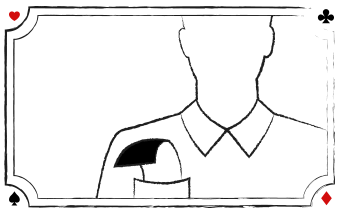
- Believe it or not, the way you dress can be effective to convey the right image. You don’t want to play blackjack wearing, say, a $1,000 Armani suit with a gold Rolex watch in a casino that caters more to low rollers. Check out the attire of the recreational players and follow their lead.
- Have a machine ticket with you, preferable sticking out of your front shirt pocket, when you arrive at the table to buy in. This gives the indication that you play slots, which most unskilled recreational players will do for fun.
- Bring along a basic strategy card with you and lay it on the table. (Placing anything on the table other than a drink is a no-no and you will be asked to pick it up; look embarrassed when this happens but continue holding the strategy card in your hand and referring to it … this is perfectly legal and it gives the perception you are an unskilled player.)
- When you buy in, hand the money to the dealer (that’s a no-no), and buy in for a small amount of money. (If you lose the initial buy-in, just dig in your pocket, purse, or better yet, a fanny pack, for more money.)
- In a hand-held game, tell the dealer you want to hit or stand rather than using hand signals.
- When you want to double down, reach across the table and manually count the chips in your betting spot (that’s another no-no) to determine how much to bet on the double down.
- Always be friendly to the dealer and floor supervisors. Try to strike up a conversation with them and fellow players while playing. (This is something you need to practice at home — keeping the count while talking or listening to someone else talking.)
- You can talk about good luck or bad luck but never mention skill.
- Feel free to complain loudly when you lose a hand because that’s normal behavior of gamblers.
- Join in when your fellow players congratulate the third base player for his smart play that “saved” the table.
- Piss and moan when you lose a bet to a dealer’s miraculous five-card 21 (or other unexpected draw that beats you).
- Try not to look intently at every card being dealt and nothing else.
You’ve got to practice glancing at the cards while also glancing at the TV (or the attractive cocktail waitresses).
- Bring a drink to the table that looks like an alcoholic beverage but isn’t. Milk it while you play.
- When you are dealt a hand, take your time deciding how to play it. Appear confused, and if a floor supervisor is close by, get his attention and ask him how he would play it. Or, ask one of your fellow players or the dealer for advice.
- Don’t stack your chips in front of you in neat piles, and don’t “shuffle” them. (Recreational players tend to be messy whereas card counters are more precise and neat.)
- When the count is high and you have a big bet up, and the cut card comes out, do not lower your bet for the start of the next shoe. (This is very slightly punitive but since your disadvantage off the top of a freshly shuffled deck is relatively small, the cost is not much.)
- If you spread to two spots on a high count, distribute your bets unevenly. For example, instead of making, say, two bets of $50, bet $40 on one spot and $60 on the other because rarely do card counters play two hands of unequal wagers.
- If you push a hand with a big bet out and the count goes down, do not lower your bet. (Gamblers usually keep the same bet up after a push.)
- Periodically, only increase your bets if the count increases and you’ve won the previous hand; likewise, if you lost the last hand, do not increase your bet. (This is slightly punitive but the cost is minimal; use this ploy only a few times per session.)
- Periodically (and discreetly) palm a chip (best are green chips, not black ones) and place it in your pocket (known as “ratholing”). At the end of the session, it will appear that you won less or lost more than you actually did. (Note: Don’t go directly to the cashier and cash out all your chips including those you ratholed.)
- When you bust a hand, just tuck your cards (rather than tossing them on the table). The dealer will admonish you for standing on a busted hand. “This guy doesn’t even know how to count.”
- If you happen to have a monster winning session, take all your chips and head straight to the craps table. Make a few bets then leave. Alternately, fake a cell phone call and announce to the dealer and the floor supervisor, “I have to leave because my wife is waiting for me.”
- After you’ve methodically drawn several cards to your hand, tuck them even though you’ve busted. (When the dealer adds up the cards in your hand, she will tell you that you busted and how you should have tossed your cards face up on the layout.)
- Throw the cards in your four- or five-card 20 or 21 hand on the table face up as if you busted. Usually, the dealer will count the cards in your hand (or often a fellow player will do it) and tell you, “You have 21, sir.”
- After losing a few hands in a row, double your bet even if the count is slightly negative.
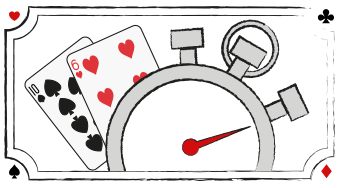
- Play for short sessions, no more than 45 minutes in the same pit. If you want to play longer, do so only during the shift change for floor supervisors; ask them beforehand what time this occurs.
- If you are having a losing session (and you will have many of them even though you are playing with an edge), blame your losses on “bad luck,” loud enough that the floorpersons will hear you.
- Buy a few keno tickets and check your numbers while you are playing blackjack.
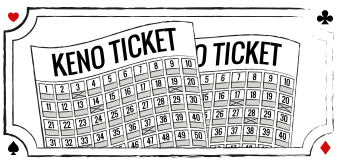
- Never be the biggest bettor on the table.
- Periodically make a tip bet for the dealer by placing the chip you want to bet for the dealer on top of the chip(s) you bet on your hand. If the hand wins, give the dealer her winning chips but let the original bet you made for her ride on the next hand.
- If the floor supervisor is at your table, offer him or her a tip. (That’s a real no-no and will definitely brand you as a complete idiot; moreover, the supervisor will, most likely, avoid going to your table like the plague.)

- Consider playing on a team. This allows excellent camouflage. (Better yet, use the Big Bettor ploy discussed in Chapter 10.10.)
- If you sense you are getting a lot of attention from the pit, either flat bet for a while or color up, making some excuse that you have an appointment.
- When the count is around 0, make a slightly large bet saying something like, “I’m due to win this hand.”
Keep in mind that the likelihood that your play will be watched by casino personnel depends on the size of your bets. If you are a low roller ($5 to $10 base bet), you will get a lot less scrutiny than someone betting green ($25), black ($100), or purple ($500) chips. The larger your bet size, the more diligent you need to be to disguise your skills.

PUNITIVE CAMOUFLAGE
This type of camouflage involves making a bad play (i.e., deviating from the basic playing strategy) to give the appearance that you are an unskilled player. The problem with this camouflage is that bad plays cost you money so you really can’t afford to make many of them; otherwise you will wipe out the small edge that you have by card counting.
Mathematicians have done extensive calculations to determine the cost of deviating from the basic playing strategy. Some of the cover plays that cost less, and, therefore, the ones you should consider using if you decide to use cover plays are:
- Doubling 8 against a dealer 6 (shoe-dealt game)
- Doubling 9 against a dealer 2 (shoe-dealt game)
- Doubling an 11 against a dealer ace (shoe-dealt game)
- Hitting 12 against a dealer’s 2 and 3
- In casinos that offer surrender, surrender hard 15 against dealer’s 9 and ace.
- Always standing on soft 18 against the dealer 9, 10, and ace
- Always taking the even money proposition when you have a blackjack
Here’s another play that will raise the eyebrows of your fellow players, the dealer, and especially the floor supervisor. When you are dealt a hard 12 against a dealer’s 2, no matter how much you have bet, double down for $1. (It costs you about a quarter for a $25 bet to really give the perception that you are a stupid player.)
(For more information on cover plays and their cost, read Chapter 7 in Don Schlesinger’s book Blackjack Attack: Playing the Pros’ Way (3rd edition), and Ian Andersen’s book, Burning the Tables in Las Vegas (2nd edition).

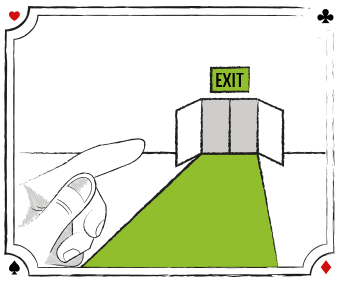
WHAT IF YOU ARE ASKED TO LEAVE?
Even when you use some of the above camouflage techniques, it doesn’t guarantee that you will never be barred from a casino. The key is to minimize this risk by using an act when you play. And when the day comes (and trust me, it will, sooner or later) and a pit boss says you can’t play blackjack anymore, don’t question him or her as to why you are getting barred, don’t get upset and scream or shout, and above all don’t touch the supervisor. Just pick up your chips and quietly leave the casino. Then when you get back home, think about how you played and what adjustments you need to make to your camouflage techniques the next time you play. Think of the experience as just another lesson learned and move on.

KEY TAKEAWAYS
In order to have a long life expectancy as a card counter, you need to develop an act that disguises the fact that you are an advantage player. This includes:- Playing and acting like a typical recreational player.
- Purposefully violating one or more rules of casino etiquette.
- Befriending the dealer and the floor supervisors.
- Giving the perception that you are there to have fun and not to win money.
- Being emotional when you play (especially when you lose).
- Not watching only the cards and nothing else.
- Making some cover plays.
- Playing for a short period of time (45 minutes maximum).

BANKROLL AND RISK OF RUIN
This chapter covers information that most players find boring. However, this information must be understood and practiced if you ever want to be a successful card counter.


DON’T OVERBET!
There are two things you must have to beat the casinos: a winning system that you play accurately and a bankroll to support your betting. Don’t take the second issue for granted because beginning your card counting career (no matter how fast you can count a deck of decks) with a short bankroll is a recipe for disaster.
I always considered myself lucky because when I first started playing blackjack nearly 50 years ago, I understood the importance of not overbetting my bankroll. Back then we didn’t have sophisticated software programs that could calculate bankroll requirements and your risk of going broke I just remembered and implemented what a trusted senior blackjack pro once told me: son, make sure your bankroll is 100 times your maximum bet.
I began my card counting career with a 1 to 4 bet spread, playing a single-deck game in Las Vegas. All I could afford was a $5 base bet, spreading up to $20 on favorable counts. Multiplying the latter by 100, yields a bankroll of $2,000. It took a while back then, but I managed to save up $2,000 and used it solely for my blackjack bankroll. The rest is history. Not once did I ever go broke, because I never overbet. When I had success at the tables and my bankroll grew, I would increase my minimum and maximums bets and still maintain the 100 to 1 ratio. Likewise, when my bankroll took a big hit, I would drop down in my betting units. Slowly, but surely, my bankroll grew over the years and so did my betting stakes and profits. I implore you to pay attention and adhere to the following principles I’m about to explain. If you do, you will succeed as a card counter; if not, I guarantee at some point you will go broke.

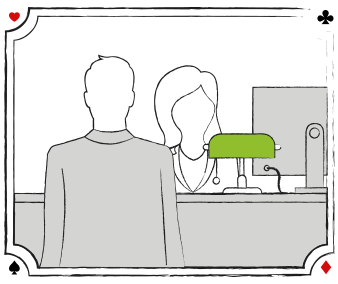
401-G
My advice to students who attend my card counting classes is to set aside a sum of money (your playing bankroll) in a money market account. Call it your 401-G (G for gambling ). This is money that you don’t need to pay present or future bills (rent, food, children’s tuition, down payment on a car or house, etc.) The 401-G should contain funds that you use solely for playing blackjack and nothing else. You withdraw money from your 401-G to play blackjack, and after playing, you deposit what’s left back into your 401-G.
(Note: At some point in the future it’s OK to withdraw a portion of your 401-G to purchase something as a reward for your success at blackjack; but in the beginning, let it grow.)
HOW MUCH BANKROLL DO I NEED?
Your edge at blackjack will manifest itself over the long run. This means in the span of a day, a week, or even several months of playing, you can experience losses. (My worst losing streak was 11 sessions in a row, even though I was playing with close to a 1% advantage. You have to have the bankroll to withstand those short-term losing sessions, and trust me, you will have them.)
Nowadays there are blackjack software programs that you can use to determine how much bankroll you need to minimize the risk of going broke. We call the latter the Risk of Ruin (or ROR). If, for example, you play blackjack with a 20% risk of ruin, it means that, for a given bankroll, if you keep playing without changing your betting scheme or bet sizes, you will eventually lose your entire bankroll 20% of the time.
The other 80% of the time, your bank will increase, and you will “never” go broke. As a general rule, successful card counters maintain enough bankroll so their ROR is 5% (or less). (Note: Playing for the same stakes, the lower the ROR, the more bankroll you will need compared to a higher ROR. Some players can tolerate a higher ROR; it depends on your risk tolerance, but my recommendation to be safe is to use 5% ROR.)
There are two types of ROR. One is known as a session or trip ROR; the other, is the lifetime ROR. The session or trip ROR will tell you what the chance is of going broke for a specific session or trip. The lifetime ROR is the chance of losing your entire blackjack bankroll, no matter how long that may take. Nowadays there are computer software programs that allow you to calculate the following: what bankroll you need for a specified ROR or vice versa (meaning, for this much session bankroll, what is my ROR).

EXAMPLE OF DETERMINING BANKROLL AND RISK OF RUIN
There are several relatively inexpensive blackjack software programs that you can use to determine your bankroll requirements and ROR. The ones I recommend are Blackjack Audit (by Dan Pronovost), Casino Vérité (by Norm Wattenberger), and Blackjack Risk Manager (by John Auston). (Note: I used the latter for the following examples although all three can do the calculations.)
Suppose you have $5,000 that you want to set aside in a 401-G to play blackjack (your “lifetime” bankroll). You are going to use the Hi-Lo card counting system and the game you plan to play is six decks, s17, and das, with 75% penetration (4.5 out of 6 decks played). Your minimum bet will be $10 and you plan to spread to $120 (1-12 bet spread). You want to know what is your chance of going broke before making as much money as you can (i.e., what is my lifetime risk of ruin?). Furthermore, you are going to spend a weekend at your favorite casino and you want to know what the probability is that you will be ahead by $1,000 sometime during the trip. And finally you’d like to know how much bankroll you should bring for the trip (“trip bankroll”) to keep your trip risk of ruin to less 5%.
You’ll need two pieces of information right up front – the game’s standard deviation and win rate. No sweat – you can get the data from, say, the BJRM software. Just input the information about this game including the rules, penetration and bet spread, click the calculate button, and instantly the software displays this result:
- Win/100 hands = 0.93 units
- Standard Deviation/100 hands = 26.51 units
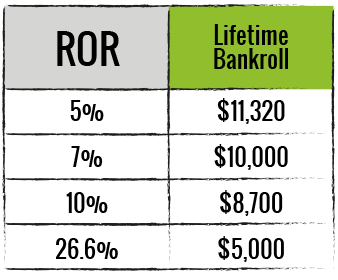
There are alternate ways to obtain the above information. You could also use a blackjack simulation software program (e.g., Casino Vérité CX) that will calculate the above information. Or if you don’t have access to a computer, you can simply go to the tables in Chapter 10 of Don Schlesinger’s book, Blackjack Attack: Playing the Pros’ Way, to obtain the data. With the standard deviation and win rate in hand, let’s answer the first question, namely “what is the chance of losing the $5,000 lifetime bankroll?” To answer this question, go to the Risk of Ruin Calculation in BJRM, and enter the standard deviation, win rate, and bankroll (in our case 500 units = $5,000). When you click on the “calculate” button, the software computes a 26.57% lifetime ROR, which is not sufficient to give you a comfortable margin of safety. (Would you want more than a 1 in 4 chance of losing your entire lifetime $5,000 bankroll? I didn’t think so.)
You can use the software to calculate what bankroll you need for a 5% ROR (or any specific ROR). Here are the calculated lifetime bankrolls and the corresponding RORs.
Notice that with a roughly $11,000 lifetime bankroll, you’ll have a much more comfortable 5% ROR. But you’ve got only $5,000 in your 401-G., so what should you do?
You have three choices:
- Fund your 401-G with more money
- Decrease your maximum bet in your bet spread (which will reduce your return, something I don’t recommend)
- Decrease your betting limits (spread $5 to $60 and recalculate your ROR).
Let’s suppose you patiently wait until you have the necessary $11,000 bankroll for a 5% ROR before you proceed to play. (A very smart choice that I always recommend to my students. While you are waiting to save money to fund your 401-G, keep practicing your card counting and basic strategy at home.)
Armed with an $11,000 bankroll, you’re ready for your long four-day weekend trip and you want to know “what is the probability that you will be ahead by $1,000 (your goal) at some point during the trip?” The assumption is that if the goal were reached you would quit playing.
You can solve for this by using the “Trip Calculation” in BJRM. The key data you need to input is the number of hands per hour (assume 100 unless you know you will be playing more or less) and the number of hours you plan to play (let’s assume 16 hours). You can now input different amounts of trip bank and goals (the latter is the $1,000 you want to win) and then let the software compute the probability of achieving your goal and your risk of ruin.
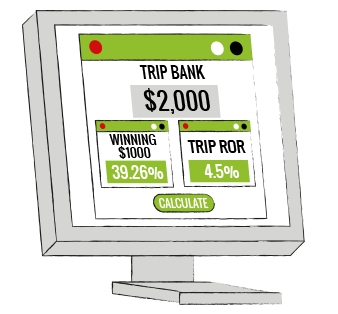
In our example, if you bring a $2,000 trip bank you’ll have a 39.26% probability of winning $1,000 at some point and a 4.5% trip ROR (i.e. risk of losing your trip bankroll). The software will easily let you change any of the variables (including trip bank) to see the effect of achieving the $1,000 goal with lower or higher risk.
So with a few key strokes and a software program that you can use at home you were able to determine the following in short order. For our benchmark 6-deck game with 75% penetration using the Hi-Lo counting system and a $10 - $120 betting spread, an $11,000 “lifetime” bankroll would be required for a 5% risk of ruin. On our long weekend trip to Las Vegas with 16 hours of planned play, you have a 39% probability of being ahead $1,000 at some point during the 16 hours if you bring a $2,000 trip bank and stick to our benchmark game and bet spread. Your trip risk of ruin is only 5%.
You can also determine bankroll requirements and ROR using the tables in Chapter 8 (Risk of Ruin) of Don Schlesinger’s book Blackjack Attack: Playing the Pros’ Way. This chapter is packed with useful information on ROR for blackjack players.

KELLY BETTING
I’d be remiss if I didn’t mention this topic. A model for how to grow your bankroll with minimum risk was developed by J. L. Kelley in 1956. He proposed that on every hand you should bet an amount that is in direct proportion to your bankroll and edge, and in inverse proportion to your variance. By doing so, you will be making larger bets when you have greater advantage, and your bankroll will grow; and when you don’t have the advantage, you bet smaller, which will protect your bankroll from ruin as it shrinks. The problem with optimal Kelly Betting is that you must accurately calculate how much to bet on every hand by multiplying your current edge on the hand times your current bankroll. (More accurately, you would divide your edge by the variance, which is the square of the standard deviation, and then multiply this result by your bankroll to determine the portion of your bankroll you should bet.) In practice, determining a “Kelly” bet is difficult to do. Moreover, exact Kelley betting can be very volatile and increases your risk that you could be spotted as a card counter by casino personnel. To minimize the latter and still use the concept of Kelly Betting, players nowadays use what is known as Half-Kelly Betting, meaning you would never bet more than half of your optimal bet on any hand.
My advice is to use the proportional betting ramp for whatever card counting system you plan to use. These betting ramps allow you to bet more (perhaps not optimally like Kelly Betting) when you have the edge and less when you don’t. They work and, in my opinion, are less taxing to use in a casino than Kelly Betting.

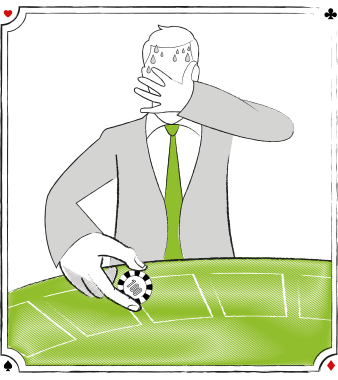
EMOTIONAL BANKROLL
An emotional bankroll means betting at a level that won’t get you sick when you lose. For example, if your hand trembles and you begin to sweat profusely when you have to push out a $100 bet, then you need to lower your betting stakes. If you can’t sleep at night after losing your entire trip bankroll, then you need to lower your stakes or seriously consider another hobby.
There isn’t a card counter alive (or deceased) that hasn’t experienced many losing trips during his career. Winning at blackjack is a journey. Along the way, you need to play beatable games with an accurate counting system and enough bankroll to withstand the short-term losses. You have a long-term advantage as a card counter but only if you push out the big bets when you have the edge, even if you’ve lost your previous big bets (the results of your previous sessions have no bearing on your current or future sessions).
As one wily card counter once told me when I was beginning my card counting career many years ago, “My boy, when you have the edge you need to load your gun with bullets and fire away or you’ll never beat this game.” (How true this is.) Bottom line: Prepare yourself for losing trips because you will experience them, and be sure that whatever your betting level, you are able to financially and emotionally make those big bets when you have the edge.

KEY TAKEAWAYS
- Set up a 401-G account for your gambling bankroll
- It’s important not to overbet if you are card counting
- You should size your lifetime and trip bankroll so that your ROR is 5% or less
- There are several commercially available blackjack software programs that can be used to determine your trip and lifetime ROR for a given bankroll
- You have to have thick skin to win at blackjack; if losing a lot of money in one or more sessions gets you emotionally sick, then card counting is not for you.

